
Edward Winter

A number of works of fiction have been reviewed in Chess Notes, although The Queen’s Gambit by the late Walter Tevis is perhaps the first that deliberately aims for that category. It traces the elevation of Beth Harmon, a prodigy in chess, drink and drugs, to the loftiest heights of the first-named vice. The plot is implausible, the language unmemorable. ‘National Master Bruce Pandolfini’ is credited by the author for ‘proofreading the text and helping me rid it of errors concerning the game he plays so enviably well’, but so much of the text rings false that either B.P. did not read the manuscript or else he knows unenviably little about the game he nationally masters.
On page 19 (of the paperback edition) it is claimed that the Sicilian is a defence to 1 P-Q4. Page 66: Morphy’s unnamed opponent would hardly be called ‘grandmaster’. Page 87: ‘She gave a non-threatening check to his king, and he pulled away delicately and began advancing pawns. She stopped that handily with a pin and then feinted on the queenside with a rook.’ Pages 104-105: a game begins 1 e4 c6 2 d4 d5 3 Nc3 dxe4 4 Nxe4 Nf6 5 Nf3. Page 146: ‘It started out as a routine Queen’s Gambit Accepted; he took the offered bishop pawn, and they both developed toward the centre.’ Page 154: the references to chess moves are most bizarre. Page 163: a mention of ‘Fornaut’ as the author of Alexander’s book on Alekhine. Page 238: references to Shakhmatni v USSR, Echecs Europe and, anachronistically, American Chess Bulletin. Page 283: an improbable suggestion of ‘Mate in 19’.
The weaving in of ‘real names’ makes it difficult to know whether Boloslavsky (page 107) is the same person as Boleslavski (pages 207 and 256). The author, who has a side-line obsession with his heroine’s stomach, tends to show insufficient ingenuity in his artificially stylized accounts of chess tournaments (e.g. lack of draws and, in the interests of suspense, having Beth meet all her strongest opponents in the final round).
(877)
Hugh Myers (Davenport, IA, USA) writes:
‘Tevis was a successful writer (The Hustler) but only an average player (he had a rating of about 1500). The technical flaws should have been corrected. It’s too bad he thought that a Chess Life columnist would be qualified to do that.’
A novel of which we have no knowledge was mentioned on page 299 of The Big Book of Chess by Eric Schiller (New York, 2006): ‘The Queen’s Gambit by Walter Titus.’
A curiosity is La petite joueuse d’échecs by Robert Belfiore (Paris, 2002), an offbeat 70-page story for children (‘à partir de 9 ans’). It concerns Octavio, an ageing, autocratic chess-lover, and Gwendolyn, a young android, and contains explanatory footnotes on Fischer, Kasparov, Elo, etc.
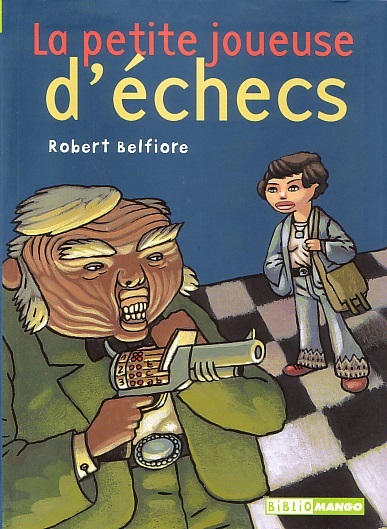
(3234)
Calle Erlandsson (Lund, Sweden) points out a chess novel for children Lang leve de koningin (“Long Live the Queen”) by Esmé Lammers, who was born on 9 June 1958. Our correspondent adds that in 1995 she directed the film of the same title and, moreover, that she is the grand-daughter of Max Euwe.
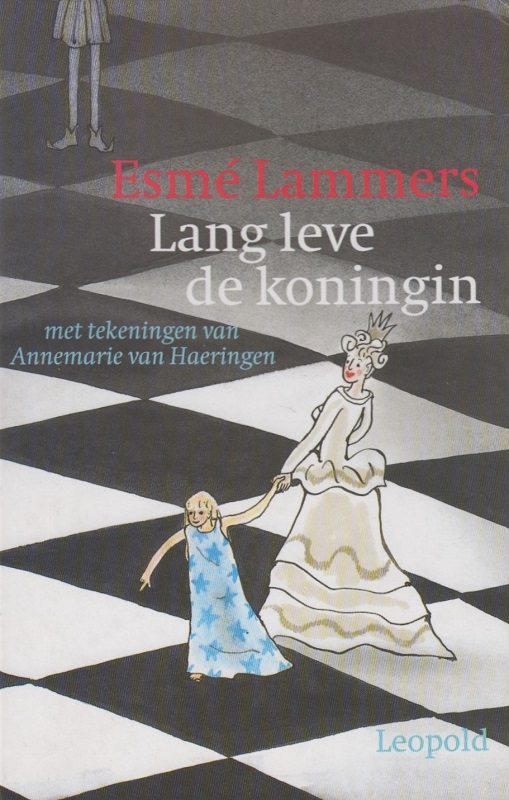
(3276)

Dangerous Game by William Harris, a 70-page paperback in the ‘Penguin Readers’ series, is available in a pack with two audio cassettes. So well performed is the (integral and leisurely) reading that it may often be forgotten that the text has been simplified for learners of English, being limited to a vocabulary of 1,200 words.
The narrator of the spooky story is a widower whose bedroom is invaded by a poltergeist for what gradually turns into a ‘dangerous game’. The sole other character is the narrator’s only friend, who visits him once a week for an evening of chess. No moves are given, but in addition to many colour pictures there is a sequence of diagrams throughout the book to depict the following game:
1 e3 e6 2 h4 c5 3 Nc3 Ne7 4 Qh5 Qa5 5 g4 b6 6 Nf3 h6 7 Ng5 g6 8 Nce4 gxh5 9 Nd6+ Kd8 10 Ngxf7+ Kc7 11 Ne8+ Kb7 12 Nd8 mate.

(3229)
Jonathan Mestel (London) comments on C.N. 3229:
‘At the request of the publisher, I composed the game which accompanies the story and tried to choose moves which reflected the narrative, and in particular the smothering of the white queen and the inevitable consequences of her death. The playful but lethal jumping nature of the knights driving the black king around had a kind of poltergeist ring to me. The dénouement with the black king and queen displaced by the knights was also symbolic of the ending.’
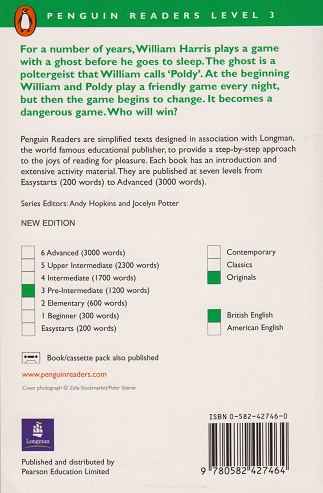
(10962)
A curiosity is La petite joueuse d’échecs by Robert Belfiore (Paris, 2002), an offbeat 70-page story for children (‘à partir de 9 ans’). It concerns Octavio, an ageing, autocratic chess-lover, and Gwendolyn, a young android, and contains explanatory footnotes on Fischer, Kasparov, Elo, etc.
(3234)
An enquiry from Philipp Kaufmann (Zurich, Switzerland):
‘I am looking for a game commented upon by Samuel Beckett which began something like “1 e4 and now the difficulties begin for White”.’
The game in question was on pages 243-245 of Beckett’s 1938 novel Murphy, the exact wording of the note to White’s first move being: ‘The primary cause of all White’s subsequent difficulties’.
Murphy – Endon
1 e4 Nh6 2 Nh3 Rg8 3 Rg1 Nc6 4 Nc3 Ne5 5 Nd5 Rh8 6 Rh1 Nc6 7 Nc3 Ng8 8 Nb1 Nb8 9 Ng1 e6 10 g3 Ne7 11 Ne2 Ng6 12 g4 Be7 13 Ng3 d6 14 Be2 Qd7 15 d3 Kd8 16 Qd2 Qe8 17 Kd1 Nd7 18 Nc3 Rb8 19 Rb1 Nb6 20 Na4 Bd7 21 b3 Rg8 22 Rg1 Kc8 23 Bb2 Qf8 24 Kc1 Be8 25 Bc3 Nh8 26 b4 Bd8 27 Qh6 Na8 28 Qf6 Ng6 29 Be5 Be7 30 Nc5 Kd8 31 Nh1 Bd7 32 Kb2 Rh8 33 Kb3 Bc8 34 Ka4 Qe8+ 35 Ka5 Nb6 36 Bf4 Nd7 37 Qc3 Ra8 38 Na6 Bf8 39 Kb5 Ne7 40 Ka5 Nb8 41 Qc6 Ng8 42 Kb5 Ke7 43 Ka5 Qd8 44 White resigns.
A descriptive passage about the chess encounters between Murphy and Endon appeared on pages 187-188 of the book.
(3526)
Page 534 of Chess An Annotated Bibliography of Works Published in the English Language 1850-1968 by Douglas A. Betts (Boston, 1974) listed, without any details, a second book by Hubert Phillips (i.e. in addition to the co-production with Golombek): a work of fiction entitled Charteris Royal (London, 1941). However, Betts had commented in his introduction (page xiv) that for entries in the Bibliography’s fiction section ‘the chess content may be minimal’, and we note that such is indeed the case with Charteris Royal. A 253-page novel, it contains passing references to chess, but the only passage of any length or substance is on page 46:
‘Chaim was 57. A mathematician of exceptional calibre, his eyesight had failed him while he was still an undergraduate at Cambridge. He took refuge for a few years in a College tutorship; but when, on his father’s death, he came into a small private income, he gave up a task for which he felt himself ill-equipped and found an outlet for his energies in chess.
Within four or five years, he was admitted to the ranks of the masters. He won the tournament at San Marino, a few years before the war [i.e. the First World War], and took third place in the big Congress at Kronsberg, where he was led only by Capablanca and Tarrasch. His reputation, in this exclusive field, seemed assured.
Now, however, came the war; and with it a fresh orientation of Chaim’s interests. Like all great chessplayers, he had studied the technique of analysis, as a thing apart from the mere trappings of the game. His mind, as he had once explained to Rusty, functioned as a sort of prism, breaking up any problem, more or less automatically, into its logical constituents.’
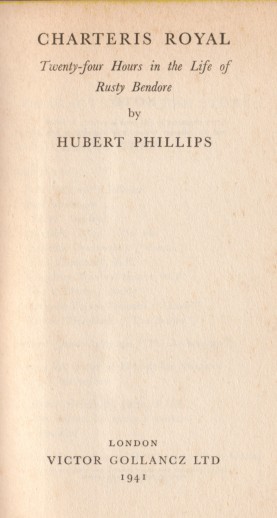
(3555)
Our feature article on Hubert Phillips: The Chess-loving Puzzle-master.
Below is a portrait of Alfred Kreymborg autographed by him in our copy of The Poetry Society of America Bulletin, November 1951, page 5:
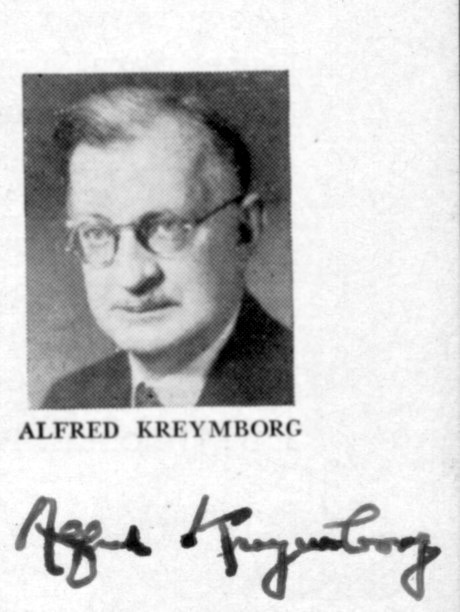
A chess-related work by Kreymborg which is known to us (leaving aside his 1933 novel I’m No Hero, which has some chess content) is his play mentioned in C.N. 3484, Queen’s Gambit Declined. Subtitled ‘A Trio in Twilight’, it was included in the Samuel French anthology New Plays for Men & Boys (New York, 1935 and 1939). We are tentatively enquiring about being authorized to bring out a reprint, as a curio in a limited edition, although the text of a one-act play, only 14 pages long, may not arouse much interest.
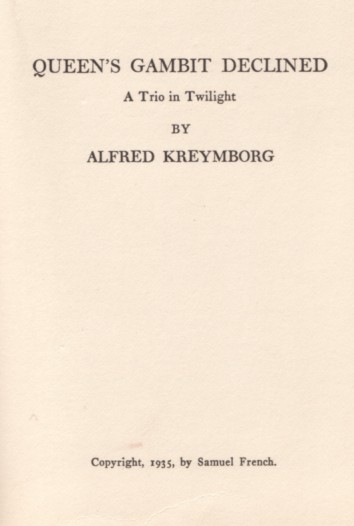
Our final word here is a reminder, and call to action, addressed to those with responsibility or influence regarding chess databases, so that anyone seeking games by Kreymborg is able to find them: there has never been a chess master named ‘Kreymbourg’.
(3569)
See too Alfred Kreymborg and Chess.
From Mark N. Taylor, who is Assistant Professor of English at Berry College, Mt Berry, GA, USA:
‘“Chess and Chessic Motifs in English Prose Narrative Since 1700: An Annotated Bibliography” aims to be a comprehensive listing of narratives which include chess in substantial or significant ways. Each entry will be annotated, summarizing the chess content. The project currently lists over 1,000 titles. The finished list will probably number between 1,500 and 2,000 titles. I welcome any assistance, particularly in identifying the less obvious books and short narratives, especially for the period 1945 to about 1985, including short stories published in chess periodicals. Anyone wishing to contribute relevant information should contact Mark N. Taylor at mtaylor@berry.edu, or at the Department of English, Box 350, Berry College, Mt Berry, GA 30149-0350, USA.’
Our correspondent has provided the following sample entry from his project:
‘Brunner, John. The Squares of the City. New York: Ballantine, 1965. 319 pp. Pbk. Intro. by Edward Lasker. (GENRE: Fantasy thriller novel by a noted science-fiction author. SUMMARY OF CHESS CONTENT: The story is not about chess but about two South American political antagonists and their followers. The main plot, however, is precisely structured according to the moves of the 16th Steinitz-Chigorin world championship match game, Havana, 1892, explained in the author’s end note. Brunner returns to this theme in his 1980 novel, Players at the Game of People, but without explicit chess references. MOTIF: life is like a chess game.)’
(3616)
‘Friendly warning: Read this only when someone is in the house with you.’
Those alluring words by Ellery Queen appeared on page 464 of his anthology 101 Years’ Entertainment The Great Detective Stories 1841-1941 (New York, 1941) by way of introduction to Lord Dunsany’s macabre short story ‘The Two Bottles of Relish’. Chess is mentioned when the narrator, a relish salesman named Smithers, refers to a conversation with the detective, Linley:
‘And so one day I said to Linley, “I wonder with all that knack you have for seeing through a chess problem, and thinking of one thing and another, that you don’t have a go at that Otherthorpe [murder] mystery. It’s a problem as much as chess”, I said.
“There’s not the mystery in ten murders that there is in one game of chess”, he answered.’
The idea is reiterated when Smithers again tries to persuade Linley to investigate the murder:
‘Well, the fact was Linley didn’t take much interest in it at first, but I was so absolutely sure that he could do it that I kept him to the idea. “You can do chess problems”, I said.
“That’s ten times harder”, he said, sticking to his point.
“Then why don’t you do this?”, I said.
“Then go and take a look at the board for me”, said Linley.’
(4142)
C.N. 3958 referred to a list of alleged chessplayers ‘featuring everyone and anyone from Adolf Hitler to Enid Blyton’. Regarding the latter, a prolific British author of children’s fiction, we have come across a number of references to chess in The Mystery of the Missing Man (on pages 37, 72-73, 76, 107 and 139 of the 1965 edition published by Armada Paperbacks, London).
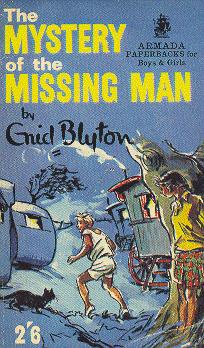
That, of course, does not make Enid Blyton a chessplayer. After quotations, the field of chess lore most fraught with imprecision seems to be catchpenny claims, made without a whit of corroboration, about celebrities’ interest in chess.
(4234)
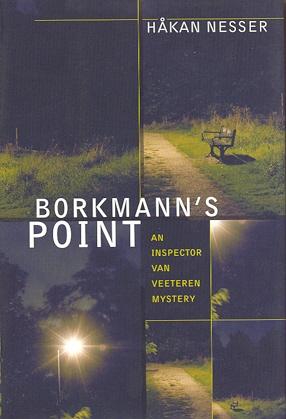
From Jeffrey Tannenbaum (New York):
‘One of the latest fictional works to use and abuse chess is Borkmann’s Point, a murder mystery by Håkan Nesser. The book, translated into English by Laurie Thompson from the original Swedish, was published in the United States in 2006 by Pantheon Books, New York. The main character is Chief Inspector Van Veeteren, who becomes engaged in a series of chess games – both literal and metaphorical – with a police chief named Bausen. Both men love to play, and dislike it when moves spoil games. The following quote is from page 270:
“They had discussed this before and reached agreement on the matter: Games should be deep-frozen after the 35th or 50th move and never completed. (Such as Linkowski versus Queller in Paris, 1907. After the 42nd. Or Mikoyan versus Andersson, 1980 – in Brest, if he remembered rightly? After the 35th, or the 37th, at any rate.) Games in which the beauty of the situation was so great that any further move was bound to ruin it.”
Nesser thus conveys some of the delight in the game, although “Linkowski” and “Queller” are not actual names of players from the Paris, 1907 tournament, won by Antoniadi and Marshall, and “Mikoyan”, “Andersson” and the Brest event are also evidently fictional. While making up names and locations in a novel may not bother anybody, the author is annoyingly imprecise with some terminology. Van Veeteren says on page 105 that he did not play the Nimzo-Indian because “there’s more oomph in the Russian”, but which “Russian” defense is an option when the Nimzo-Indian is reachable? On the next page Van Veeteren laments that he can accept a loss as Black but that “when he had the white pieces and was able to use the Russian opening, there was no excuse”. On page 105 the author (or translator) also refers to rooks as “castles”, an old-fashioned word that few chessplayers would use today, and on page 270 he has one of the players asking if the other has prepared a “defense against the Sicilian”, as if the Sicilian were an attack by White. The detective does use some terms properly as metaphors, as when, on page 313, he describes a telephone call that he made to help find the killer as “an opening gambit”, which another character says was “more of an endgame”, since the solution to the case was imminent.’
(4252)
References to chess in comic book fiction seem rare, but an example is shown here from the 9/1981 issue of The Mighty Thor:
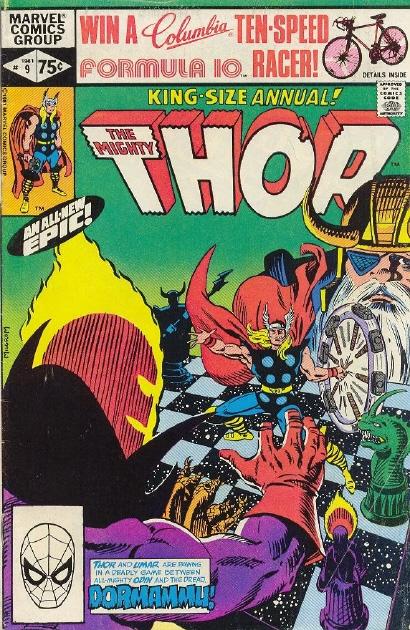
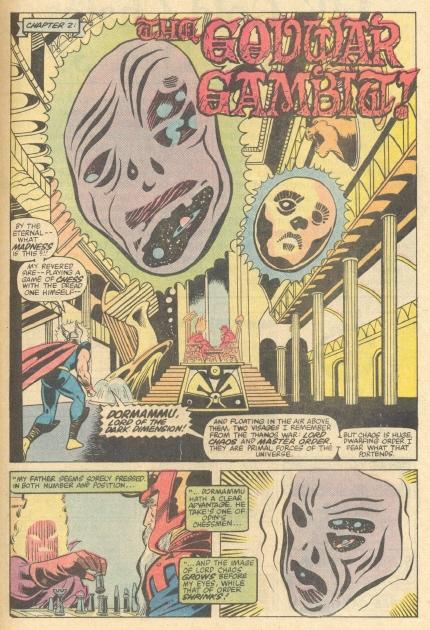
A further specimen of the dialogue is given below:
‘I was ensorcelled by Umar and her G’uranthic Guardian. They stripped away my Asgardian persona ...’
(4400)
The Capablanca Opening by David T. Chantler (New York, 1977). ‘A novel of intrigue.’
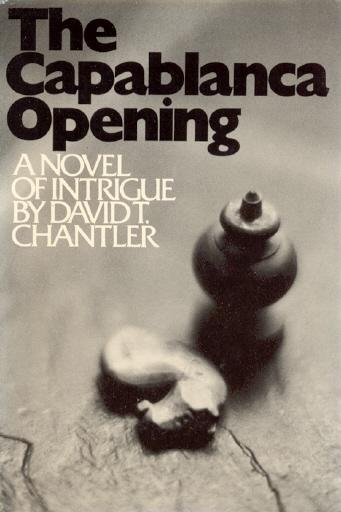
Ahora juega usted Señor Capablanca by Mario Zaldívar (San José, Costa Rica, 1994 and 2000). A novel starring Capablanca, set in the early 1930s.
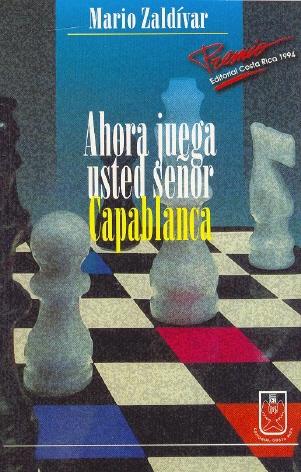
(4576)
Richard Reich (Fitchburg, WI, USA) writes:
‘A fantasy series by George R.R. Martin (four volumes so far) is popular. The latest volume, A Feast for Crows, refers to a noble family named Staunton and has a character named Alekyne. Martin was once a tournament director for Bill Goichberg’s Continental Chess Association in the United States.’
(4608)
A justly celebrated work of fiction, ‘Last Round’ by Kester Svendsen (1912-68) was included in, for instance, Reinfeld’s The Treasury of Chess Lore and Chernev’s The Chess Companion. It originally appeared on pages 121-126 of Chess World, 1 June 1947, and page 142 of that issue described Svendsen as ‘a professor at the University of Oklahoma’ and identified the game featured in the story as Charousek v Wollner, Kaschau, 1893.
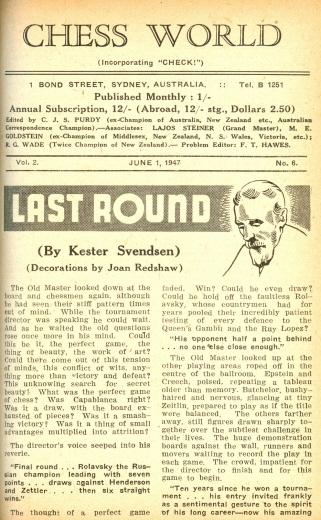
The game received international attention in 1897, being published on page 145 of the May Deutsche Schachzeitung and page 317 of the August BCM. The latter mentioned as its source Magyar Sakkujság, and we should like to know whether that Hungarian periodical supplied further details. The venue is sometimes mistakenly given as Vienna.
Page 45 of volume three of Magyar Sakktörténet (Budapest, 1989) stated that the game was played on 9 April 1893, and the book had several other games between Charousek and Wollner. These were also included in Chess Comet Charousek by V.A. Charuchin (Unterhaching, 1997). From elsewhere in the Magyar Sakktörténet series we know that Wollner’s forename was Jakob, and any biographical information about him will be welcome. [Correction in February 2009: Fabrizio Zavatarelli (Milan, Italy) pointed out to us that the Hungarian series gave the forename as Jakab, not Jakob.]
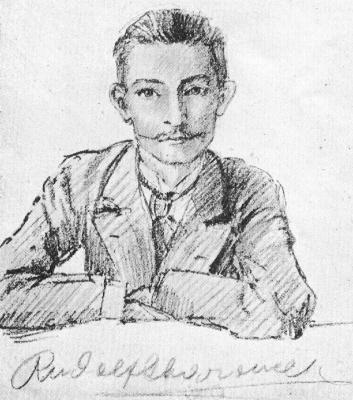
Rudolf Charousek (sketch from life by Mrs G.A. Anderson, Chess Pie, 1922, page 67)
(4941)
From page 34 of CHESS, December 1941:
‘Maurice Leblanc, author of the famous series of novels about Arsène Lupin, the gentleman crook character, has just died in Perpignan, aged 75. He used to work, in all kinds of weather, in a small open shed in the grounds of his house. At 5 p.m. each day he used to retire to his bedroom, draw the curtains and sit for hours in complete darkness planning his next day’s work. He believed that his fondness for chess helped him to work out his plots.’
Wanted: documentation about Maurice Leblanc’s interest in chess.
(4989)
From the June 1913 American Chess Bulletin, page 140:
‘Charles Henry Meltzer, writing in the May Cosmopolitan of Maurice Leblanc, the creator of the fictional character, Arsène Lupin, says that Monsieur Leblanc, when asked from whence he received the motif for the deeds of this famous criminal, replied:
“I have read Edgar Allan Poe and studied Balzac. All the romance of crime was suggested in Poe’s works. I don’t remember anything besides Poe and Balzac that could have helped me to work out my plots – unless my fondness for the game of chess was useful. Chess helps one to make plays. And why not novels?” – The Star of Hope.’
(5029)
Recommended for German speakers: Burghart Klaußner’s fine reading of Robert Löhr’s novel about Wolfgang von Kempelen’s invention, Der Schachautomat (five CDs produced by Der Audio Verlag GmbH).
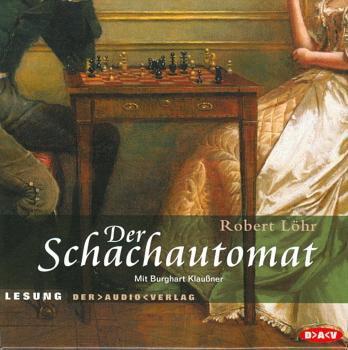
Concerning the book itself, we note from the dust-jacket of the English edition, The Chess Machine (New York, 2007), that ‘the rights have been sold in more than 20 countries’.
(5153)
Matthew O’Hara (Arvada, CO, USA) draws attention to a webpage
regarding The
Pride
and the Sorrow (‘a novel about Paul Morphy’). [Note on
5 November 2019: broken link.]
The author, Matt Fullerty (Washington, DC, USA), informs us that he hopes to have his book published in the summer of 2008.
(5240)
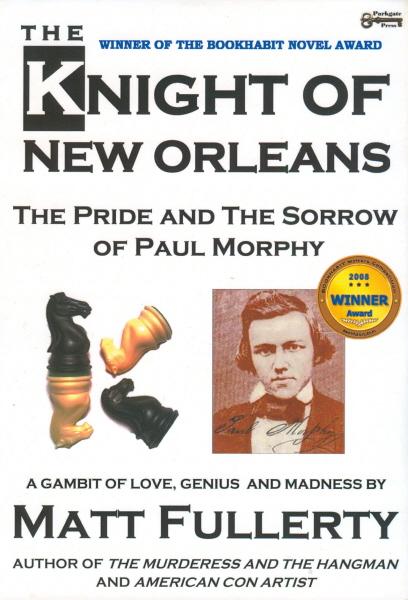
Matt Fullerty’s novel about Paul Morphy, The Knight of New Orleans, has been published recently, a 556-page hardback. Its introductory pages describe Emanuel Lasker as ‘World Chess Champion for 27 years (1894-1918)’ and Louis Paulsen as ‘Swedish-American’; in rapid succession there are also references to ‘Amserdam’ and ‘aritocrats’ and a misattribution to ‘Grandmaster [sic] Rudolph [sic] Spielmann’ of the book/magician/machine quote, which dates from the nineteenth century (see C.N. 4156). From an initial skim of the novel itself we noted off-puttingly frequent misspellings of French words and expressions, and the book has taken a low place in our reading pile.
(7419)
From Mark N. Taylor:
‘Dorothy Dunnett (1923-2001) wrote a series of historical novels with chessic titles, of which only the fourth in the series, Pawn in Frankincense (London, 1969), had actual chess content. Chapters 25–26 (pages 428-446 in the 1996 Vintage trade paperback edition) feature a deadly chess game with living pieces. There is enough specific description to plot out the opening moves, but not enough to reconstruct the entire game. Bill Marshall, a friend of the author, claimed that Dunnett had a diagram on which the endgame was based, but she died before she could locate it. In 1999 Marshall reconstructed the initial position and the early moves in “The Chess Game in the Seraglio”. The webpage has not been updated since; nor have I seen any further discussion about it. So the mystery remains: how did the game end? Was it based on a pre-existing endgame problem? If so, can it be identified?’
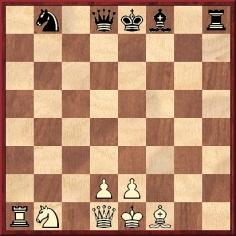
(5271)
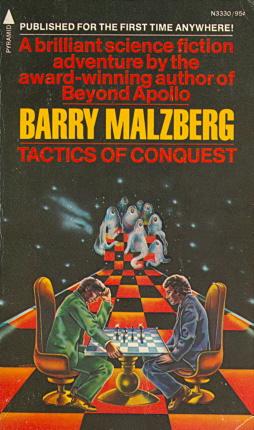
Evidently written in the immediate aftermath of the Spassky-Fischer world championship match, Tactics of Conquest by Barry Malzberg (New York, 1973-74) is, according to the front cover, a ‘brilliant’ novel by an ‘award-winning author’. The first page of text reads:
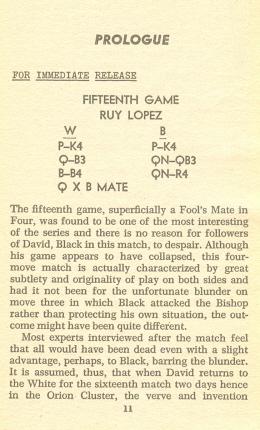
Two pages later the award-winning author gives a prose account of this gamelet, which somehow culminated in a bishop being captured:
‘White’s opening move P-K4 is a conventional Ruy Lopez but Black’s responding P-K4 indicates that he is in a “fighting mood” and ready to “join the battle”. White’s second move, an over-ambitious posting of the queen, indicates an open game; Black’s response, a quick development of the knight, shows that he is following for the moment convenient lines of Ruy Lopez still.
It is at White’s third move, B-B4, that the match becomes truly original, making its first contribution to the literature on outstanding contests. It is an obvious attempt to play a fighting game in the center of the board: The temporary abandonment of the queen further reveals the true openness of the contest. Black’s response, attacking the queen, is a rugged joining of the battle. Deviating from the Ruy Lopez on the third move and its conventional Sicilian, Black has shown himself willing to move into truly uncharted waters. One can only admire and be awed by the depth and profundity of this move.
White’s sudden capture of the black bishop, forcing mate, is, of course, unfortunate in that it could be said to bring the game to a swift conclusion, although grudging credit must be given for its ingenuity ...’
Mr Malzberg’s ineffable approach to describing chess play is further shown on page 51:
‘He began with a King’s Pawn attack; I countered at the sides, bringing out the king knight and castling early in a variation of the Nimzo-Indian; a Queen’s Gambit he offered was declined ...’
And, again, on page 149:
‘He could not take the bishop because it would leave a hanging pawn ... and if I were then to take the open rook behind the bishop, I would have a devastating discovered check. The bishop could go queen-side, it could go down the line to double-check, it could pause to go on nibbling on a rook. And nothing to be done. The double-knight maneuver pinned him.’
To avoid the narrative flow being clogged up, or bogged down, with explanations of technicalities, the book concludes with a seven-page glossary of chess terms, such as the following (from page 166):
‘Ruy Lopez: ... This attack involves a penetration of the center by the king and queen’s pawns with the subsequent rapid opening of the bishop file, from which squares the knights may control the center. Direct and powerful attack meant to march down the board; it is easily defeated by a Sicilian defense in which the advance of the pieces is blocked. Now in partial disfavor, the Ruy Lopez has been displaced by the modernists. It is still often seen in amateur games. The Ruy Lopez is capable of producing a Fool’s Mate against an inexperienced or nervous player who might fail to note positioning of the queen and king’s bishop.’
The same page affirms:
‘Sicilian defense: A common refutation of the Ruy Lopez, employed by many experts and well within the technical facilities of all grandmasters.’
Page 165 says that the rook is ‘considered to be half as powerful as the king’.
The novel itself features much indiscriminate name-dropping, in the tradition of general chess writing. A specimen from page 147:
‘Indeed it has a long and honorable history, this discovered attack. Most notably it was used by the long-deceased Frank Marshall in his famous “shower of gold” game against a then world champion in New York City at the turn of the century. Unfortunately it was not in a tournament game.’
Seldom are names dropped accurately. From page 33:
‘I motioned to the omnipresent pocket chess set, at this time poised in midst of a replay of the Immortal Game, the Andersson queen having penetrated to the seventh rank for that masterful sacrifice.’
Andersson, of course, should not be confused with Anderssen, or Immortal with Evergreen. Or Anderssen with Steinitz, given what appears on page 72:
‘Adolf Andersson, author of the Immortal Game, challenged God publicly, in his last years, to a game of chess. “I’ll give him pawn and move”, said Andersson.’
One final sample passage comes from the previous page:
‘Later in his life Steinmetz, the first official (as opposed to merely “recognized”) world champion, begged to meet Morphy who finally agreed only on condition that the meeting was for ten minutes and chess was not discussed. Morphy eventually died of tuberculosis. Annals do not reveal if he and Steinmetz ever met.’
There has never been a chess novel quite like Tactics of Conquest. For writing about the royal game with such uninhibited indifference to the concerns of grouchy purists, the award-winning Mr Barry Malzberg could surely be granted, with ease, one further accolade, however belatedly: a chess award.
(5355)

From Mark N. Taylor:
‘In my forthcoming bibliography (mentioned in C.N. 3616) I describe Barry Malzberg’s Tactics of Conquest as an “anti-chess” novel. The historical inaccuracies (or, at least, most of them) and puerile descriptions of chess moves are quite deliberate. The novel, however, betrays only rare instances of self-awareness of the absurdities:
“There is a very definite scholarly point of view, of which I am the sole proponent, which holds that the game was invented in Peru somewhere in the middle of the sixteenth-century and that all of the ensuing political struggles of the world can only be seen as a series of stumbling, halting efforts to get back to its purest inceptions and outlines.” (Page 108)
“It is possible that certain aspects of this memoir are fabricated, but not all of them are.” (Page 157)
All of the games are poorly played and poorly explained because they are played by adolescent boys of no special talent, and not by 50-year old grandmasters as we are first given to believe. The narrator is one of the boys, a Fischeresque character, but lacking Fischer’s pleasantness and sanity. The hype surrounding their match for “the fate of the universe” is a product of the narrator’s imagination, probably influenced by the hype of the Spassky-Fischer match (as you inferred in C.N. 5355). The reason why the narrator detests his opponent so rabidly and why the match signals in his mind the final struggle of good against evil is not revealed until the Epilogue, a piece of nastiness which I shall not repeat here.
That said, not everything in the novel is humbug, and Malzberg can sometimes be thoughtful. For example:
“Chess too is an artifact, a set of ruins in which, however distantly, may be perceived the intricate and terrible outlines of a long-perished civilization. All of us, grandmasters and patzers alike, in our obsessive quest across the board, our attempts to find the proper combinations and patterns which will lead to some understanding of the game (the game has never been truly understood, even by Fischer, even by Alekhine) are merely stumbling to unearth some gleaming and true artifact which will bring us the message fully and unlock the way to the secret, hidden treasure.” (Page 107)
I regard this “anti-chess” novel most charitably as an experiment, and a not very successful one. In my opinion, being deliberately bad disqualifies it for any sort of anti-award.’
(5363)
From Yasser Seirawan (Amsterdam):
‘I am currently writing a romance/adventure novel which features a chess theme. It was originally written in 1980 and 1981, but a baggage mishap during a flight to Berlin caused me to lose my only (handwritten) copy. Laptops did not exist in those days. Now, half a lifetime later, I have revived the project. How many grandmasters have written a novel?’
Two works come to mind: Belye i chernye by A. Kotov (Moscow, 1965) and Los Voraces 2019 by A. Soltis (Jefferson, 2004). Regarding the former, which concerned Alekhine’s life, see C.N. 4073 for information about the ensuing film. The dust-jacket of the Czech translation of the novel (Prague, 1971) is reproduced below:
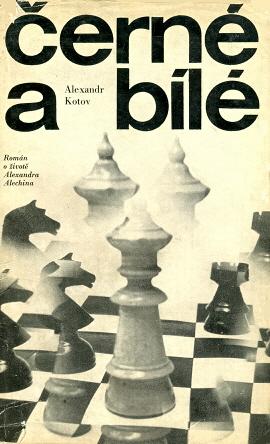
(5366)
From Rod Edwards (Victoria, BC, Canada):
‘Regarding C.N. 4325 and previous items on woodpushers, woodshifters, etc., I have come across an early version of a similar term, although not as old as the eighteenth-century quote from Diderot. Page 162 of Etienne Cornil’s treatise on the Café de la Régence (C.N. 5241) gives the first page of a play, “Mat” by Charles Joliet, in which there was a character named Poussebois, a chessplayer.’
Below is the first page of the play, as published on pages 225-232 of La Stratégie, 15 August 1883:
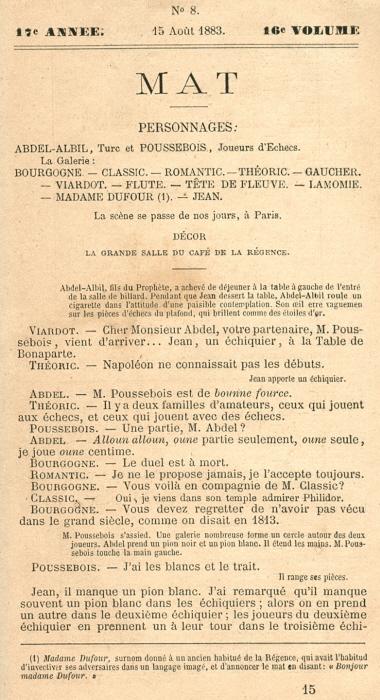
The text can also be found in the Traité-manuel des échecs by Henri Delaire (e.g. on pages 188-198 of the Paris, 1917 edition). The obituary of Charles Joliet (1832-1910) on page 64 of the February 1910 issue of La Stratégie showed that he was a prolific literary figure.
(5378)
Dan Scoones (Port Coquitlam, BC, Canada) writes:
‘C.N. 5378 reminded me of the short story “A Strange Simultaneous Display” by Marc Benoit on pages 203-208 of The Best In Chess by I.A. Horowitz and Jack Straley Battell (New York, 1965). The protagonist, Holz Schieber, fresh from a match victory over the Russian player Tolkai Derevyachkou, is induced to give a simultaneous exhibition against two local players in the small Quebec town of Poussebois. Schieber’s opponents conspire to copy the master’s moves so that, in effect, he is playing against himself. To subvert the plot he deliberately makes an illegal move on the first board. The second opponent dutifully follows suit, and Schieber immediately demands that the second opponent correct the illegal move. This allows him to send the two games down different paths, but it is all for nothing because he ends up losing both games. Of course, the names Holz Schieber, Tolkai Derevyachkou and Poussebois all translate (more or less) as “woodpusher”.’
The story had been published on pages 108-109 of the April 1954 Chess Review.
(5567)
Below is the obituary of Charles Joliet in La Stratégie, February 1910, page 64:
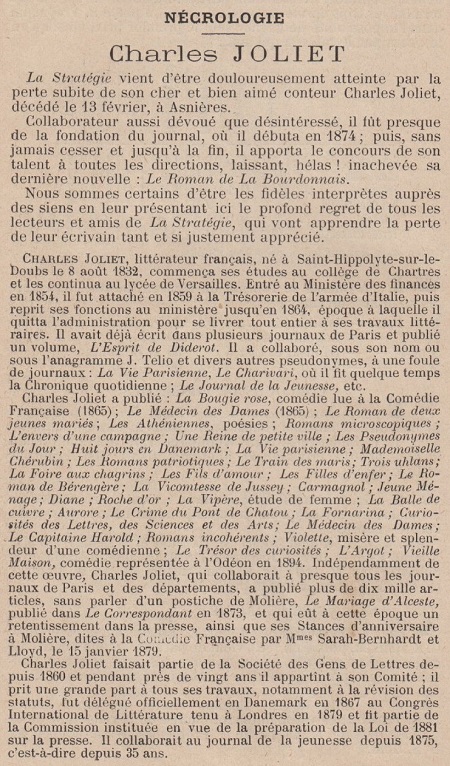
One of his novels with references to chess is Trois Hulans (Paris, 1872):
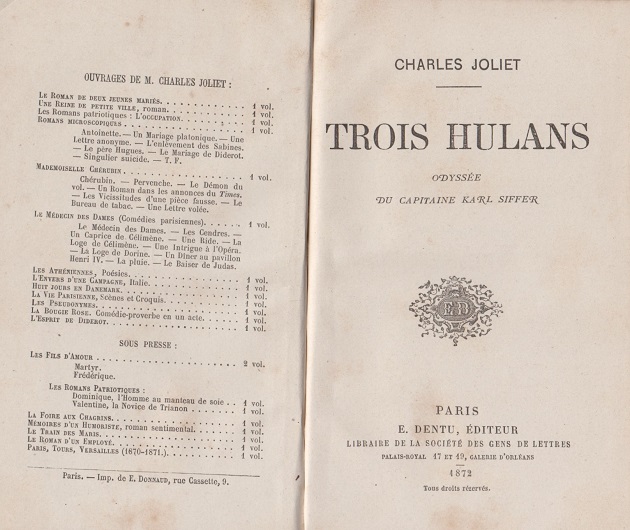
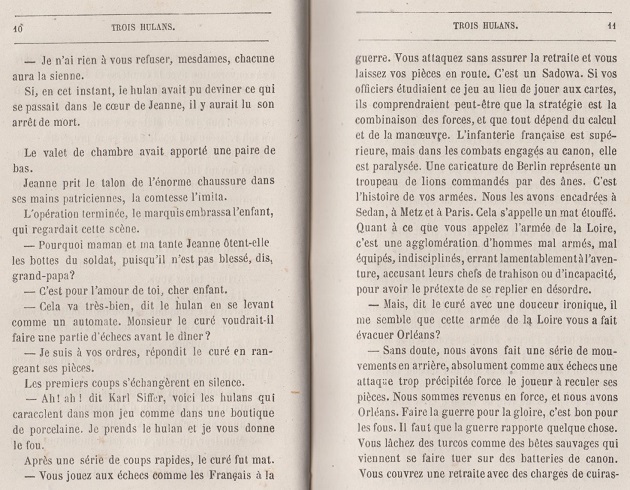
In that chess passage a non-chess matter may be mentioned. The reference on page 11 to ‘un troupeau de lions commandés par des ânes’ is a reminder that the familiar phrase ‘lions led by donkeys’ did not, as sometimes imagined, originate in the First World War.
(9125)
Juan Carlos Sanz Menéndez (Alcorcón, Spain) submits the following:
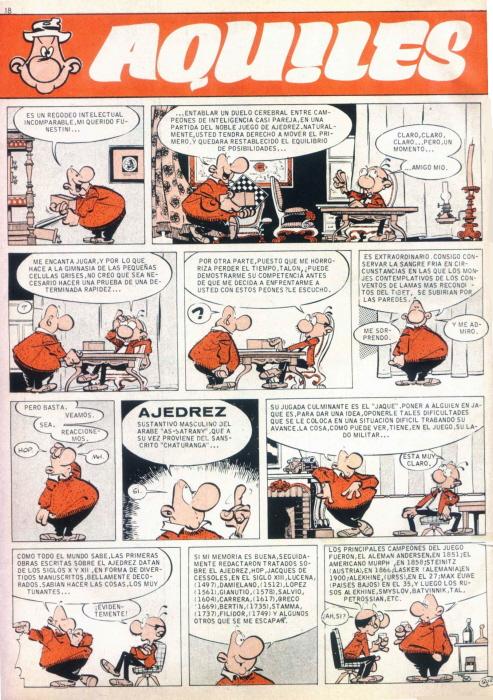
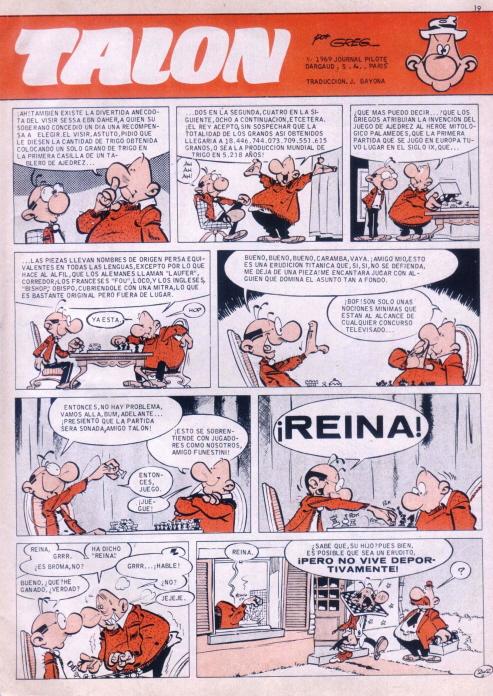
‘Aquiles Talón’ on pages 18-19 of Gran Pulgarcito, number 50 (1970), the original having appeared in the French magazine Pilote
(5418)
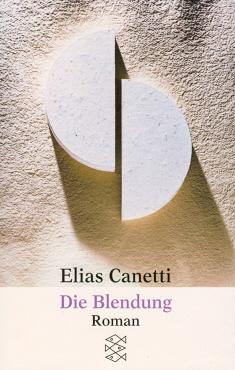
The chessplaying Fischerle/Fischer coincidence in Elias Canetti’s 1935 novel Die Blendung (published in English in the 1940s under the titles Auto-da-Fé and The Tower of Babel) is too well known to be discussed here, but when and by whom was the coincidence first pointed out, and did Canetti ever comment on it?
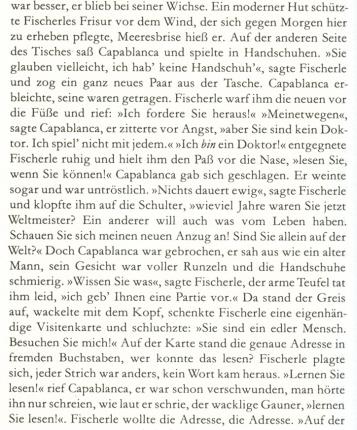
Above is an excerpt from page 380 of the 2005 Fischer Taschenbuch Verlag edition, while the passage below comes from page 200 of Auto-da-Fé:

(5507)
As reported on page 331 of Kings, Commoners and Knaves, it was claimed on page 100 of The Sorcerer’s Apprentice by D. Bronstein and T. Fürstenberg (London, 1995) that during the Second World War Tartakower was several times ‘dropped by parachute behind enemy lines on secret missions’.
No evidence for the assertion has ever been traced, and now we note the following passage on page 278 of Moral Victories by David Lovejoy (Mullumbimby, 2008):
‘Bronstein subsequently told me that his source was a French journalist who talked to him many years earlier. Bronstein was inclined to doubt the story, but his editor insisted on including it for colour. (Telephone conversation with Bronstein, March 2006.)’
This appears in the book’s factual End Notes. Subtitled, ‘The Story of Savielly Tartakower’, Moral Victories is an historical novel (a 285-page paperback), and we shall be pleased to forward to Mr Lovejoy any messages from readers who are interested in ordering a copy.

(5519)
Javier Asturiano Molina (Murcia, Spain) draws attention to the front cover of Jaque y ... mate! (Montevideo, 1976), a collection of mystery stories selected by Alfred Hitchcock:
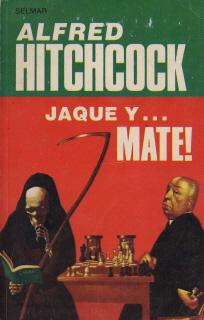
The English edition was entitled Death-Mate (New York, 1973):
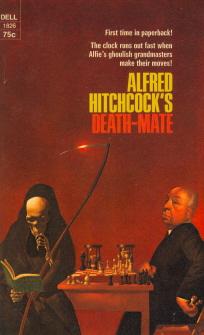
(5530)
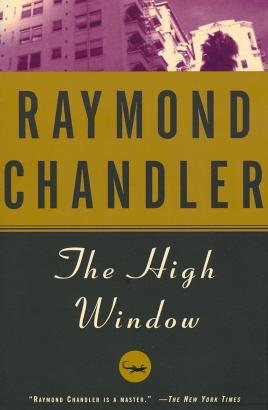
Dominique Thimognier (St Cyr sur Loire, France) quotes the final paragraph of Raymond Chandler’s novel, featuring Philip Marlowe, The High Window (1942):
‘It was night. I went home and put my old house clothes on and set the chessmen out and mixed a drink and played over another Capablanca. It went 59 moves. Beautiful cold remorseless chess, almost creepy in its silent implacability.
When it was done I listened at the open window for a while and smelled the night. Then I carried my glass out to the kitchen and rinsed it and filled it with ice water and stood at the sink sipping it and looking at my face in the mirror.
“You and Capablanca”, I said.’
Our correspondent notes four victories by Capablanca in 59 moves (all as White): against J. Corzo (Havana, 1901), Oskam (Middelburg, 1911), Whitaker (Washington, 1915) and Horowitz (New York, 1931).
We add that the first of these was given on page 130 of The Unknown Capablanca by David Hooper and Dale Brandreth (London, 1975), with this concluding note:
‘An endgame of master class, apart from a few hesitations; but even a master would hardly play it as fast – a rate of 147 moves an hour.’
It seems highly unlikely, however, that the game was ever accessible to Chandler. Although published in the Cuban press at the time, it was long regarded as untraceable. It was presented in an article by Paul Leith on pages 325-326 of the November 1960 BCM, following research by Miguel Alemán.
The Oskam game was given on pages 38-39 of our monograph on Capablanca, taken from the Middelburgsche Courant of 9 September 1911. Our book (page 87) also included the Whitaker game, from pages 70-71 of the April 1915 American Chess Bulletin. Both victories occurred in simultaneous exhibitions.
Capablanca’s (tournament) win over Horowitz has always been readily available, without being widely anthologized.
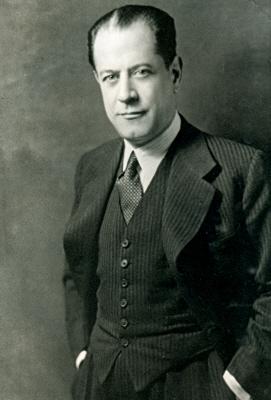
José Raúl Capablanca
The High Window has a number of references to chess, and particularly in chapter 15, which begins:
‘The chessmen, red and white bone, were lined up ready to go and had that sharp, competent and complicated look they always have at the beginning of a game.
... I opened a little paper-bound book of tournament games published in Leipzig, picked out a dashing-looking Queen’s Gambit, moved the white pawn to queen’s four, and the bell rang at the door.’
Two or three pages later Marlowe says to his visitors:
‘I play over tournament games that have been recorded and published. There’s a whole literature about chess. Once in a while I work out problems. They’re not chess, properly speaking. What are we talking about chess for? Drink?’
(5611)
Leibel Dearson (Jerusalem) draws attention to the following remark by George Bernard Shaw:
‘As I write these lines the newspapers are occupied by the exploits of a child of eight, who has just defeated 20 adult chessplayers in 20 games played simultaneously, and has been able afterwards to reconstruct all the 20 games without any apparent effort of memory. Most people, including myself, play chess (when they play it at all) from hand to mouth, and can hardly recall the last move but one, or foresee the next but two.’
Source: Back to Methuselah. A Metabiological Pentateuch by G. Bernard Shaw (London, 1921), page xxv.
The prodigy in question was evidently Reshevsky.
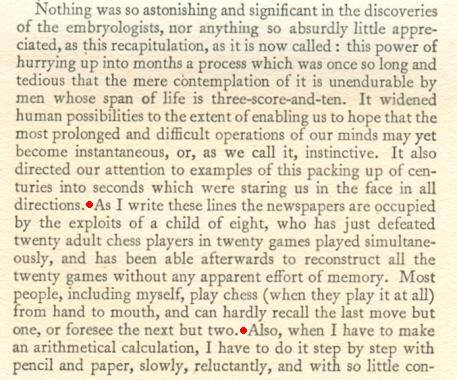
The best-known remark about chess by Shaw appeared in The Irrational Knot:
‘Playing with Ned! No: he hates chess. He says it is a foolish expedient for making idle people believe they are doing something very clever when they are only wasting their time. He actually grumbled about the price of the table and the pieces; but I insisted on having them, I suppose in remembrance of you.’
This was quoted, in part, on page 30 of Chess Pieces by Norman Knight (London, 1949), after which Knight reported that he had asked Shaw whether he still held that opinion. In a postcard dated 22 August 1946 Shaw replied:
‘I have no recollection of the passage. I am hopeless as a chessplayer; I never can see more than two moves ahead. I was taught the names of the pieces and the moves by my Mother when I was a child; but my genius did not point in that direction.’
Page 21 of King, Queen and Knight by Norman Knight and Will Guy (London, 1975) quoted from Shaw’s The Admirable Bashville:
‘The world’s a chess-board,
And we the merest pawns in fist of fate.’
(5627)
Any colourful approbation or disapprobation of chess in the output of an eminent literary figure is liable to be quoted as representing his own views even if expressed only by a character in a work of fiction. An example concerning George Bernard Shaw was given in C.N. 5627, and we now show how Fred Reinfeld handled the matter on page 119 of the April 1952 Chess Review:
‘Shaw sneered that chess is “a foolish expedient for making idle people believe that they are doing something very clever, when they are only wasting their time”. Such comments are of little value, for the only information they give us is that their authors fumed at their own execrable chessplaying.’
Below is the exact context of Shaw’s words, from page 283 of The Irrational Knot (London, 1905). As stated in the Preface (page vii), he wrote the novel in 1880.
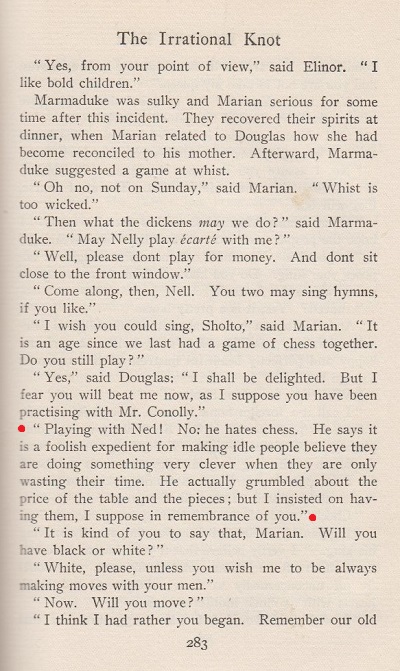
On the Internet, furthermore, it is possible to find the misquotation ‘a foolish experiment’.
(9413)
Some alleged quotations:
‘Life’s too short for chess’ – Henry James Byron;
‘Chess is a foolish expedient for making idle people believe that they are doing something very clever, when they are only wasting their time’ – George Bernard Shaw;
‘Chess is possibly the only game in the world in which it is impossible to cheat’ – John Steinbeck.
The Internet is awash with such pseudo-quotes. All have been discussed in C.N. (see the Factfinder) and are examples of a practice referred to as follows in C.N. 9413:
Any colourful approbation or disapprobation of chess in the output of an eminent literary figure is liable to be quoted as representing his own views even if expressed only by a character in a work of fiction.
Another case will be examined now:
‘Chess is as elaborate a waste of human intelligence as you could find anywhere outside an advertising agency’ – Raymond Chandler.
A point of evident indifference to some chess websites is that the essentials of this ‘Chandler quote’ have been examined in fine style on a Quote Investigator page. It was a remark by the narrator, Philip Marlowe, in The Long Goodbye, a novel by Raymond Chandler (London, 1953 and Boston, 1954).
We add that the text was discussed by Montgomery Major, the then Editor of Chess Life, in D.J. Morgan’s Quotes and Queries column, in the November 1957 BCM, pages 294-295:
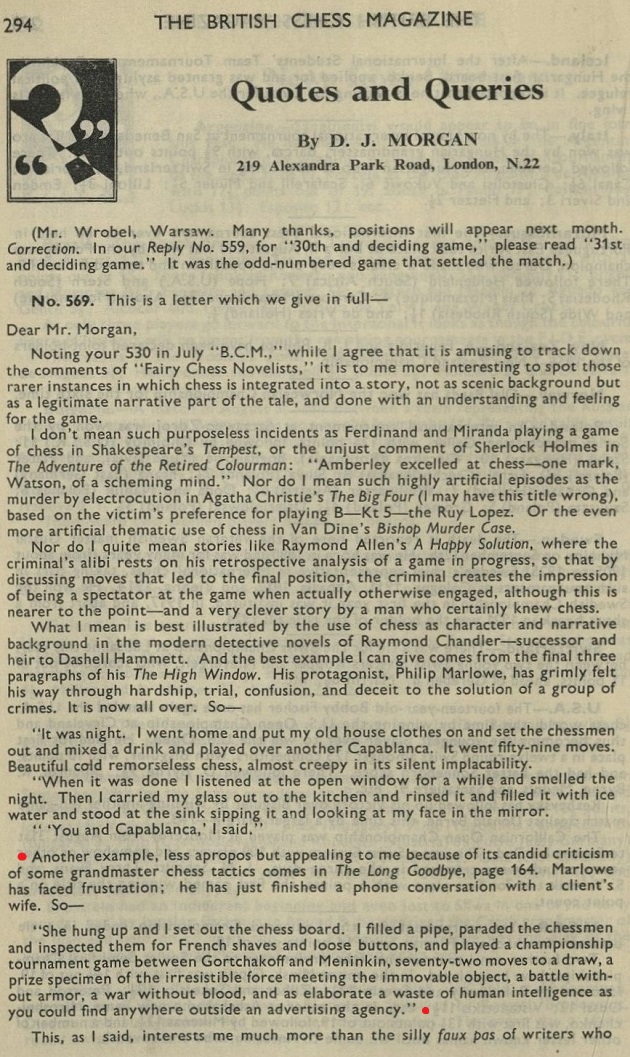

Below is the relevant part of The Long Goodbye, with full context, on page 128 of the first US edition:
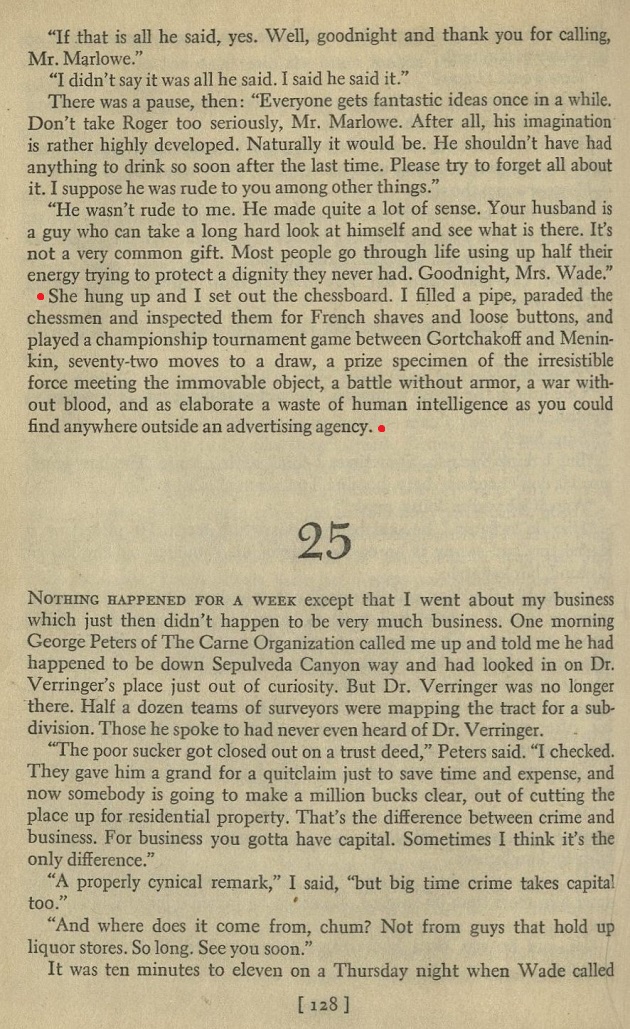
The highlighted passage, consisting mostly of one long sentence, prompts us to underscore Montgomery Major’s observation about ‘candid criticism of some grandmaster chess tactics’: the private detective’s comment about ‘a waste of human intelligence’ refers not to chess in general but to the 72-move draw between Gortchakoff and Meninkin.
An earlier Quotes and Queries item (number 181 on page 154 of the May 1954 BCM) also concerned Raymond Chandler and The Long Goodbye:
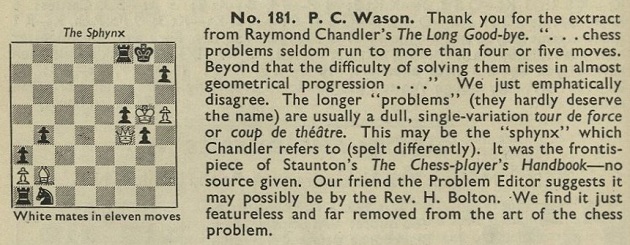
From pages 194-195 of the US edition of the novel:


Regarding the Sphynx problem, our feature article Howard Staunton includes the brief text of C.N. 1190:
In New in Chess issue 3/1986 the readers’ letters section suddenly comes alive with a series of excellent contributions on the Sphynx problem in Staunton’s Handbook.
In 2016 the matter was discussed in admirable detail by Michael Clapham in his Chess Book Chats series. See part one and part two.
The scans in the present article have been provided by the Cleveland Public Library. As so often, we are greatly indebted to Mr William Chase and Mr Raymond Rozman.
(12177)
Luca D’Ambrosio (Bolzano, Italy) informs us of a new novel about Capablanca, by Fabio Stassi: La rivincita di Capablanca (Rome, 2008):
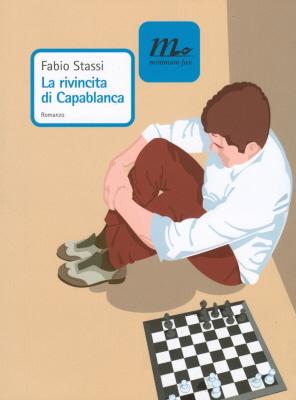
(5758)
Albert Frank (Brussels) asks which crime novel featured A. Troitzky’s famous study (Novoye Vremya, 1895) with mate administered by a single bishop.
It was The Bishop Murder Case by S.S. van Dine (New York and London, 1929). We reproduce pages 264-265 of the edition published by Grosset & Dunlap, New York:
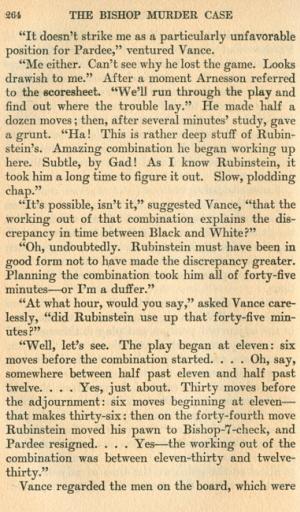
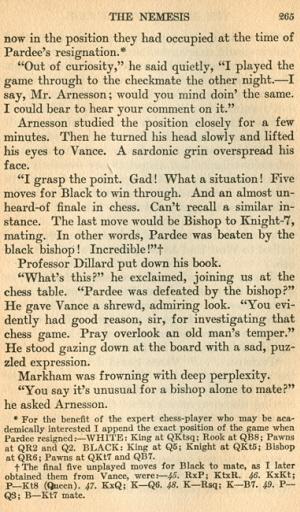
Below is an item from page 55 of the March 1929 American Chess Bulletin:
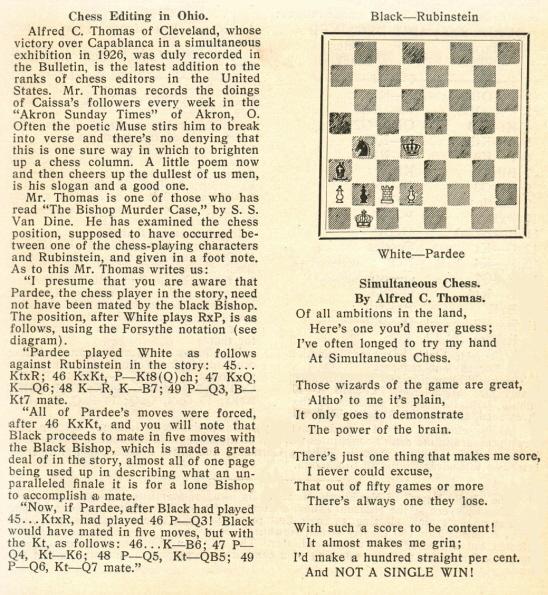
From the above-mentioned edition of van Dine’s book comes this picture:
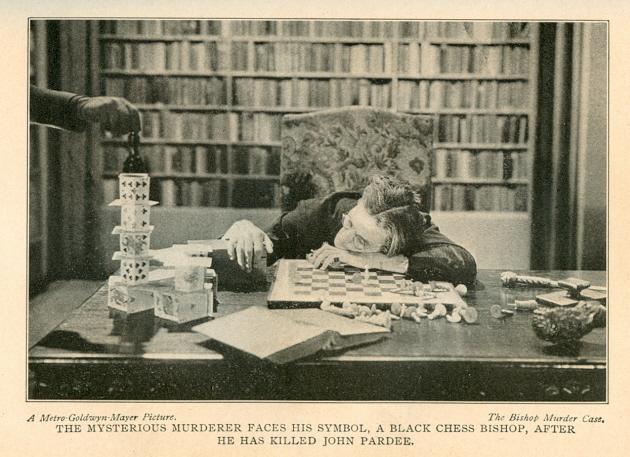
(5948)
A photograph of Alekhine with the novelist was given in C.N. 5126 from page 129 of the July-August 1929 American Chess Bulletin:
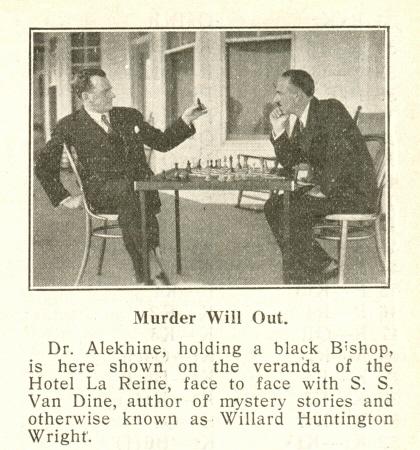
(5948)
From Mark N. Taylor:
‘On page 287 of Means Davis’s novel The Chess Murders (New York, 1937) a character remarked regarding H.J.R. Murray’s work: “I wouldn’t take that book too seriously”.
Davis also introduced two chessic phrases which never caught on: “playing chess on it” (page 263), i.e. thinking about a problem as a chessplayer thinks about a position), and “it wouldn’t be chess” (pages 300-301), i.e. it would not be fair or admit a logical response).’
(5978)
Mark N. Taylor draws attention to John and the Chess Men by Helen Weissenstein (New York, 1952 and London, 1955), a children’s story which frames a beginner’s chess primer.
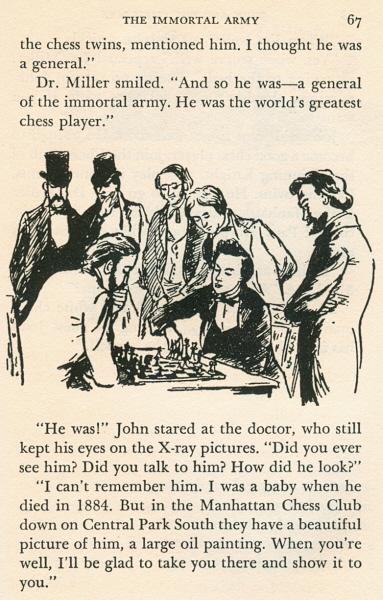
We have a great liking for the book. With considerable skill the author not only teaches the chess basics but gives guidance on etiquette and incorporates some chess history and lore (Franklin, von Kempelen and Morphy).
(6362)
The famous short story ‘The Thinking Machine’ by Jacques Futrelle (1875-1912) was mentioned by P.W. Sergeant in the first paragraph of his article on Deschapelles on pages 117-119 of the April 1916 BCM:
‘Some years ago the late Jacques Futrelle, who was one of the Titanic victims, wrote a book called The Thinking Machine on the Case, describing certain exploits of a “famous scientist” who out-Sherlocks Sherlock Holmes in the detection of mysteries. In one of the stories in the series we read how the Professor after one hour’s instruction in the game of chess, hitherto unknown to him, defeats the Emmanuel [sic] Lasker of his day, using his logical faculty to supply the place of experience in the game. Now Jacques Futrelle, it need hardly be said, was no chessplayer. But there was a chessplayer flourishing a century ago who apparently asked the world to believe about him the same marvel as Futrelle puts before us in the imaginary case of The Thinking Machine. And this player was no other than Deschapelles.’
A website dedicated to Futrelle has the full text of the short story [note on 5 November 2019: broken link], and below we reproduce from page 7 of his anthology The Professor on the Case (the title of the British edition of The Thinking Machine on the Case) a passage which has intrigued chess enthusiasts:
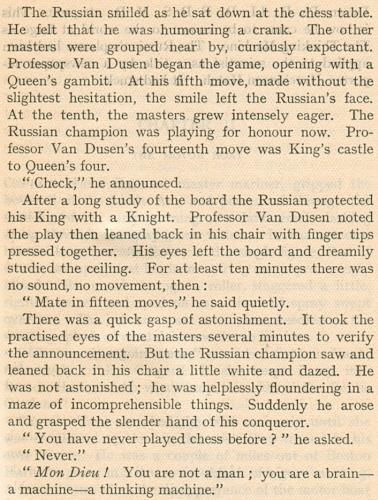
Alain C. White discussed Futrelle in his article ‘Chess in Detective Stories’ on pages 305-309 of the August 1911 BCM, and regarding the game which Professor Van Dusen (having only just been introduced to chess by Hillsbury) won against the champion Tschaikowsky, A.C. White wrote:
‘It must have been a remarkable game, though; and anyone who could reconstruct it from the graphic description would confer a lasting favour on lovers of “brilliants”.’
Decades later another eminent figure raised the reconstruction question. From page 205 of the June 1948 BCM:
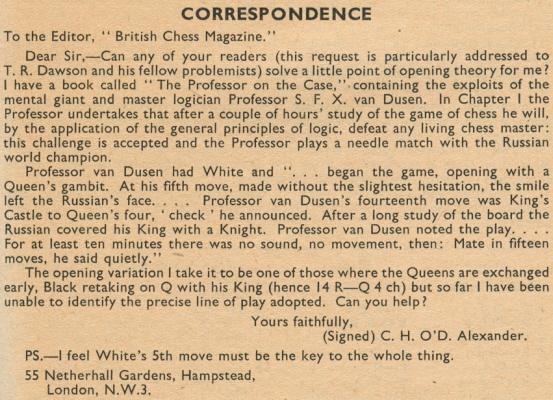
It needs to be considered whether 14 Rd4+ could be a discovered check.
(6652)
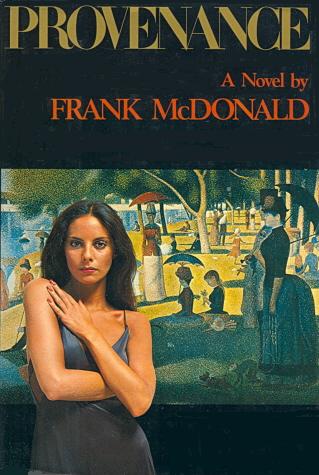
In C.N. 1912 (see pages 169-170 of Chess Explorations) Bob Meadley (Narromine, NSW, Australia) provided extracts from Provenance, a work of fiction by Frank McDonald. Our illustration is the front cover of the first edition (Boston, 1979), pages 3-4 of which have two of the passages pointed out by our correspondent:
‘... Weiller introduced a brilliant twist to the Walthier Variation of the Rook’s Gambit Declined and broke his defenses.’
‘The light from the fire reflected in his ruby episcopal ring as he moved his queen’s pawn to knight-five.’
(6800)
Many reports are available on the Internet about a riot during the first-night performance of a play at the Shaftesbury Theatre in London. Chanting erupted in the auditorium. Leaflets and stink-bombs were unleashed, the curtain had to be lowered several times, and the police intervened to eject the demonstrators.
The protests were directed against the play’s leading man:
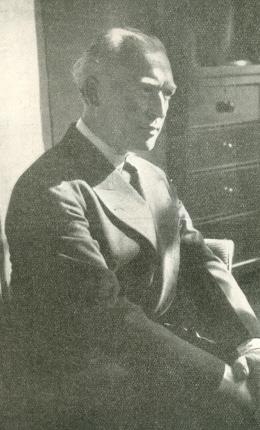
Werner Krauss
These events occurred on 28 September 1933, the protesters’ grievance being that Werner Krauss was German. The news went around the world. Page 14 of the Courier Mail (Brisbane) of 30 September 1933 stated that there were cries in the theatre of ‘Down with Hitler. We won’t let Krauss appear. We want British actors’.
The play was Before Sunset by Gerhart (also spelled Gerhardt) Hauptmann, in an English adaptation by Miles Malleson. The above picture of Krauss is taken from the theatre programme, as is this synopsis:
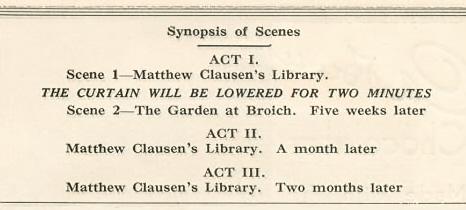
On a milder level, far removed from the concerns of the anti-Fascist movement, a complaint about the play from L.C. Birch was published on page 500 of the November 1933 BCM:
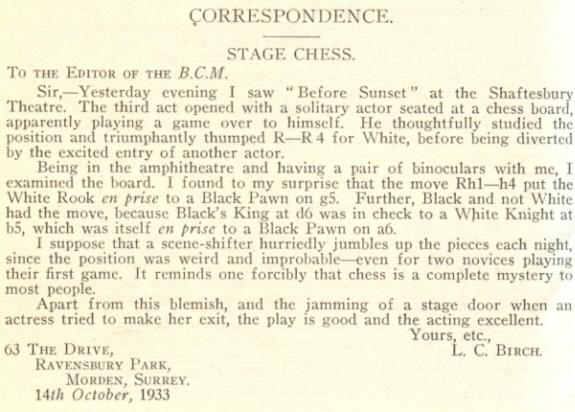
The play contains several chess-related passages, such as the following, which we reproduce from page 39 of Vor Sonnenuntergang (‘Schauspiel von Gerhart Hauptmann’ – a work in five acts), published in Berlin in 1932:
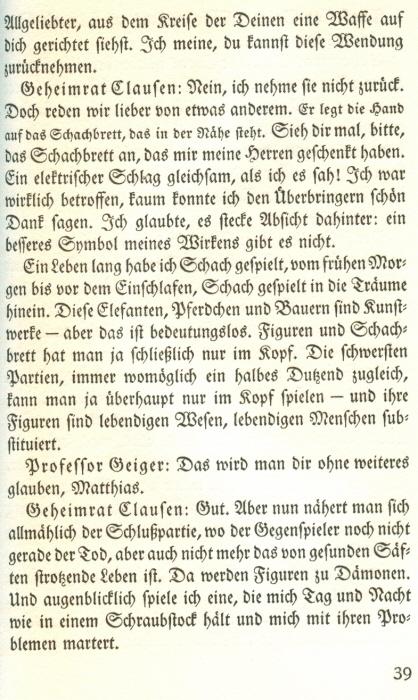
To assist us in preparing a follow-up item, does any reader have access to an English-language version of the play?
(6841)
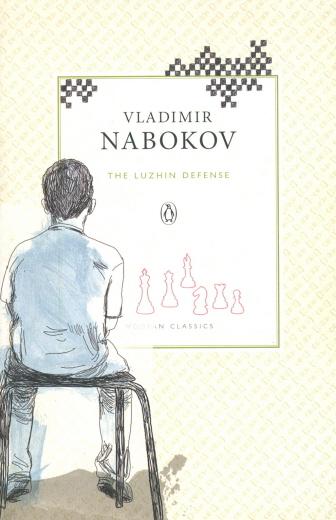
With regard to Vladimir Nabokov’s novel The Luzhin Defense Georges Bertola (Bussigny, Switzerland) asks whether Nabokov had any personal contact with Curt von Bardeleben, who, a few years before the novel’s publication, had committed suicide in a similar way to Aleksandr Luzhin. Our correspondent comments that Nabokov lived in Berlin in the early 1920s and began work on The Luzhin Defense in 1924, the year of von Bardeleben’s death. He also forwards this quote from page 1492 of volume one of Œuvres romanesques complètes Nabokov (Paris, 1999):
‘Dans l’avant-propos de L’exploit, Nabokov fait allusion à un autre joueur d’échecs, Bardeleben, “mort dans des circonstances analogues à celles de son personnage Loujine”. Ce joueur fut champion d’Allemagne et se suicida en 1924 se jetant d’une fenêtre.’
Documentation from readers on any direct connection between Nabokov and von Bardeleben will be much appreciated.
A paragraph from our article Chess in 1924 may be recalled here:
‘On 31 January Curt von Bardeleben, desperately impoverished, committed suicide by throwing himself out of the second-floor window of his residence in Berlin. Nowadays he is seldom mentioned except for his loss to Steinitz at Hastings, 1895, a game which Napier nominated as the finest ever played, and it is all but forgotten that in the same event von Bardeleben defeated the then world champion, Lasker. His many brief matches included wins and draws against masters of the standing of Blackburne, Teichmann, Spielmann and Leonhardt, but today it is almost as if they had never been played.’
Below is the first part of von Bardeleben’s obituary on pages 21-22 of the January 1924 Wiener Schachzeitung, relating the circumstances of his death:
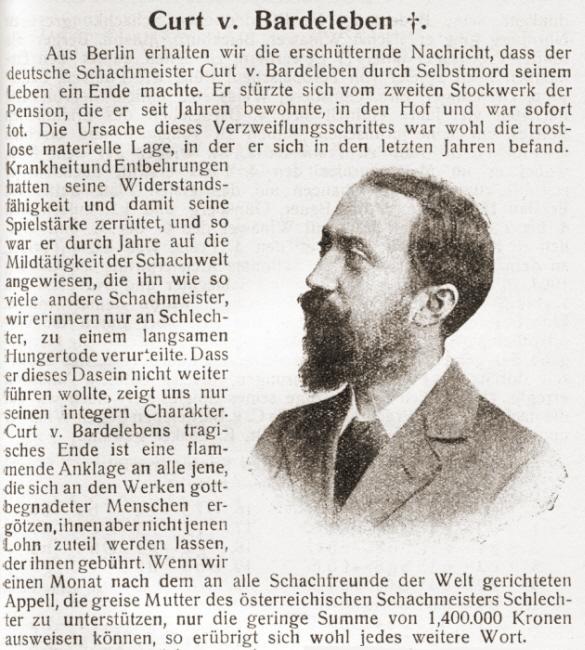
The illustration above is the best-known shot of von Bardeleben, being based on a photograph published opposite page 306 of the Hastings, 1895 tournament book. An earlier picture, from page 97 of the December 1888 Chess Monthly, was given in C.N. 5049. The only latter-day portrait of von Bardeleben that we recall was reproduced from the Sonderheft 2 of Kagans Neueste Schachnachrichten,1924 in an article by Peter Anderberg on Fritz Sämisch (Kaissiber, April-June 2010, page 55). It is reproduced below courtesy of Mr Anderberg and the Editor of Kaissiber, Stefan Bücker:
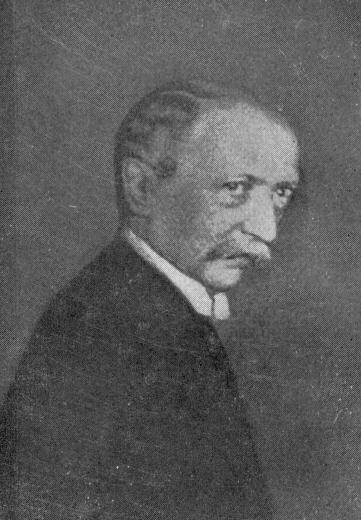
Curt von Bardeleben
Regarding The Luzhin Defense, a notable review by C.J.S. Purdy was published on pages 30-32 of Chess World, February 1965. Purdy did not mention von Bardeleben but considered it likely that ‘the story of Rubinstein gave Nabokov part of the idea’.
(6852)
The back cover of a recent work of fiction, Paul Morphy: Confederate Spy by Stan Vaughan (Milwaukee, 2010):
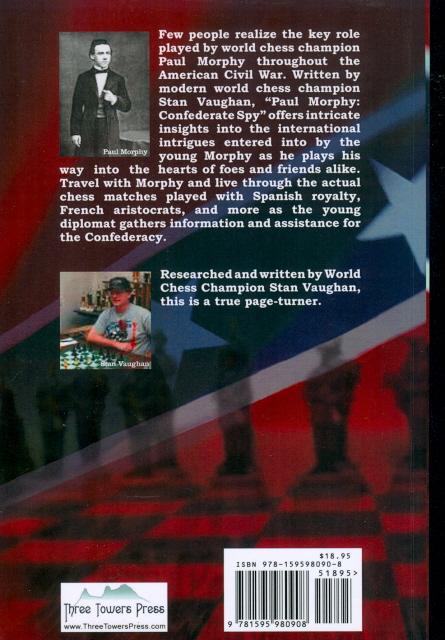
There is more information about the ‘modern world chess champion’ on the final page. It is stated, for instance, that S. Vaughan has the following titles and accomplishments:
(6919)
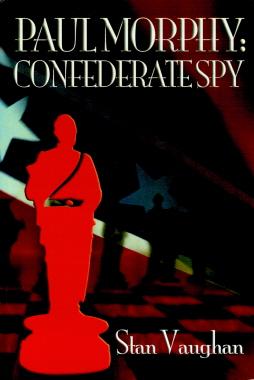
Rick Kennedy (Columbus, OH, USA) informs us that, as related on his webpage, he has noted cases of plagiarism. For example, page 63 has the following:
‘... an undigested cube of rock, and whoever designed it failed to realize that when plumbed down beside the delicate Moorish palaces upon which it encroached, it could only look ridiculous.’
Mr Kennedy found the identical passage (except for ‘plumped’ and ‘encroaches’) on page 227 of Iberia by James A. Michener.
As a small test of our own we opened the Morphy book at random and found, on page 113, whole chunks of text lifted by S. Vaughan from the website Exploring Toledo.
[Addition on 2 August 2013: the above Toledo link is not currently working.]
(7427)
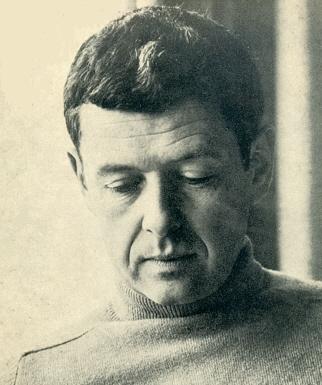
This photograph of James Whitfield Ellison comes from the dust-jacket of his chess novel Master Prim (London, 1968).
Pages 189-198 included a 29-move game between Julian Prim and Eugene Berlin, and that part of the story was reproduced on pages 143-146 of A Book of Chess by C.H.O’D. Alexander (London, 1973). Alexander did not identify the game, which was Alekhine v Sterk, Budapest, 1921.
C.N. 2830 (see pages 2-3 of Chess Facts and Fables) discussed that brilliancy prize game, noting that Alekhine’s first volume of Best Games contracted it by one move.
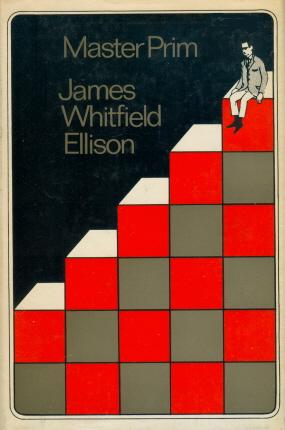
(6934)
An early example of a comic strip with a chess theme comes from the ‘Rhymo the Monk’ series by Gus Mager. It was reproduced on pages 320-321 of the October 1905 American Chess Bulletin, courtesy of the New York Evening Journal:
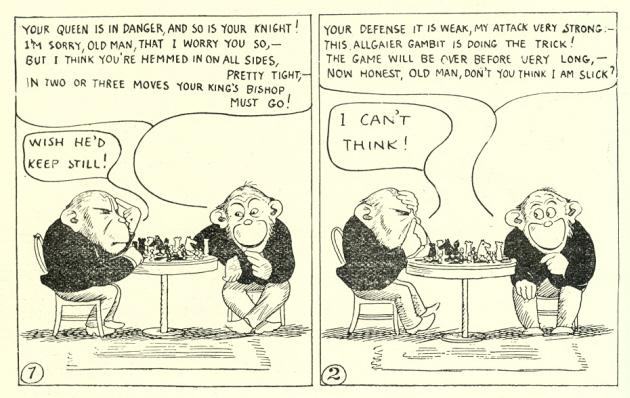
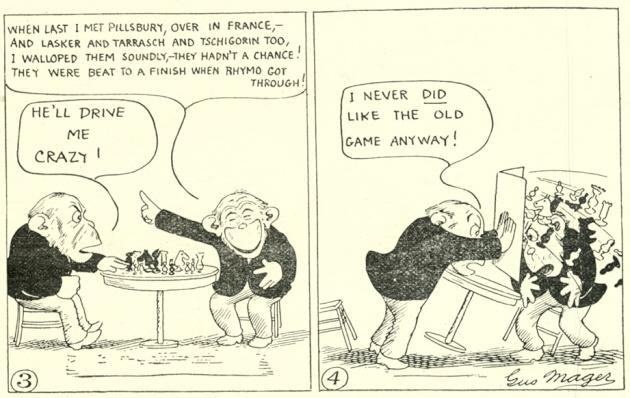
(7234)
Morten Hansen (Frederiksberg, Denmark) points out another chess-related comic strip, dating from the early 1970s. Its Danish title is ‘Skak’, but the story originally appeared in Spanish, the artist being Esteban Maroto. The English version, ‘Chess’, was first published in issue 41 of the magazine Eerie in 1972.
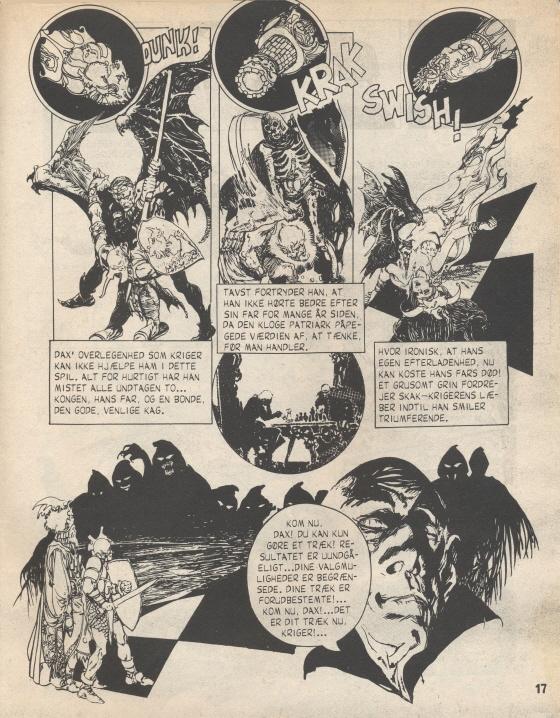
The plot is summarized by Mr Hansen as follows:
‘Dax the warrior is challenged to a game of chess by a sorcerer who calls himself the chessmaster of the universe. The sorcerer explains that Dax will have the white pieces and that they will consist of Dax’s dead friends and relatives. They have been called back from the long night of death, but if Dax loses the game they will be gone forever. The black pieces consist of various monsters and demons. Dax is no match for the sorcerer, and the white pieces fall one by one until finally Dax’s father, acting as the white king, is cut down by the black queen. The enraged Dax breaks the rules of the game, slaying the black queen for revenge, whereupon the equally enraged sorcerer expels Dax, who wakes up next to the severed head of his father.’
(7285)
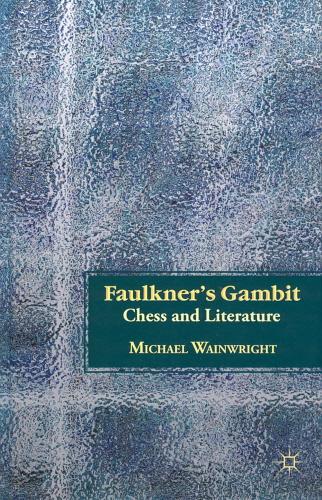
Also added to the reading pile is Faulkner’s Gambit (subtitle: Chess and Literature) by Michael Wainwright (New York, 2011). It ‘examines the chess structures, motifs, and imagery in William Faulkner’s only novella, situating this critically neglected work within both a historical and literary context’. A central thesis is that Faulkner’s character Gavin Stevens in Knight’s Gambit was inspired by Paul Morphy.
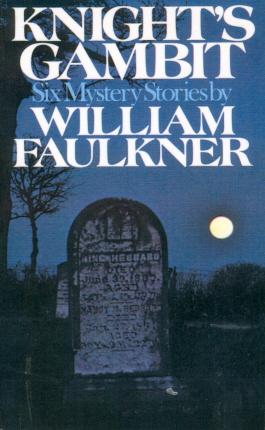
(7420)
Wanted: information about this picture, which was published on page 42 of the May 1992 issue of the British Airways magazine High Life:
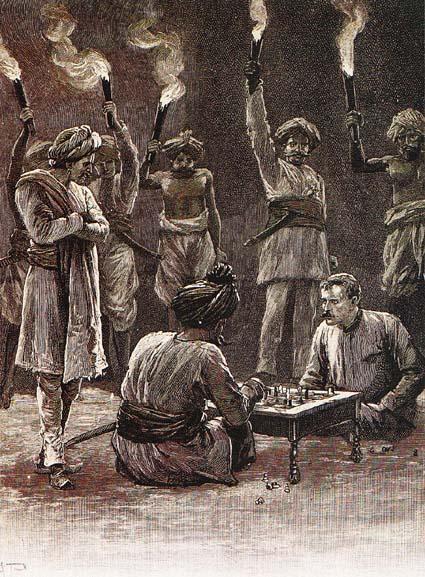
(7430)
Pete Klimek (Berkeley, CA, USA) reports that this was an illustration in ‘The Black Knight’, a story by Raymund Allen in volume three of The Strand Magazine, 1892.
(7438)
We have acquired the April 1892 issue of The Strand Magazine, which had the short story ‘The Black Knight’ by Raymund Allen on pages 330-338. The four illustrations featuring chess are given below from, respectively, pages 330, 331, 332 and 337:
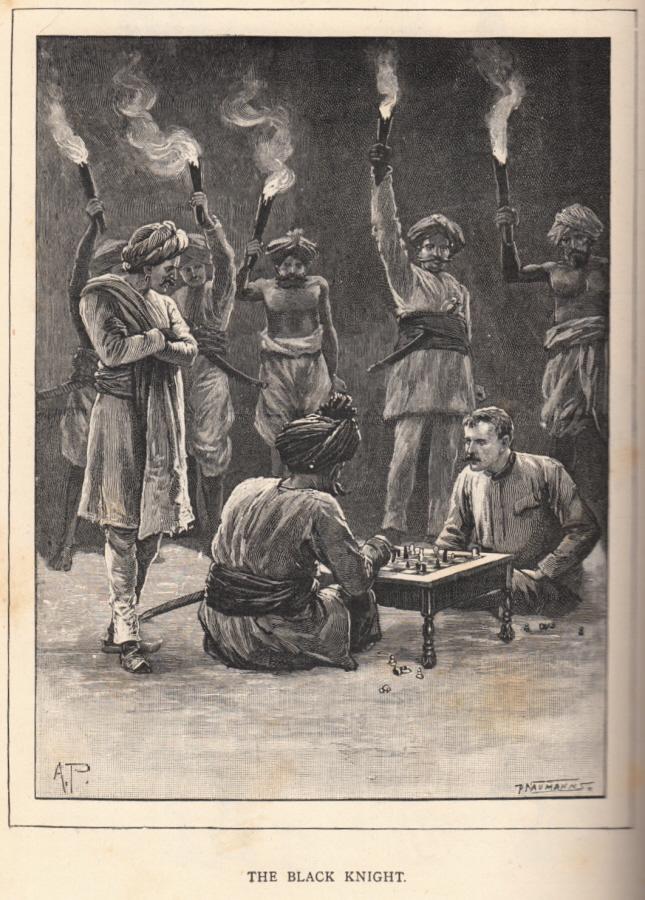
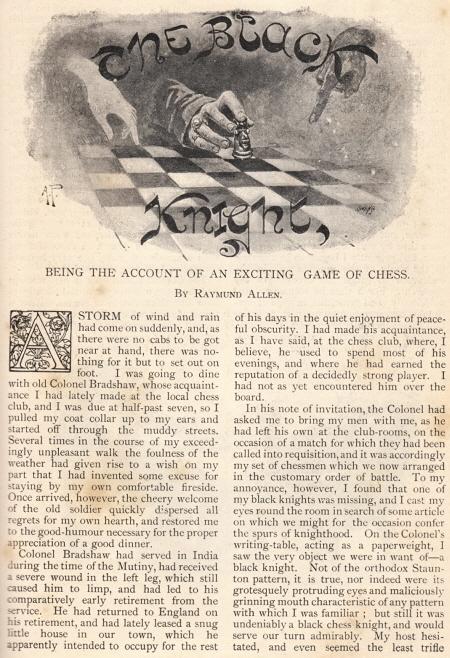
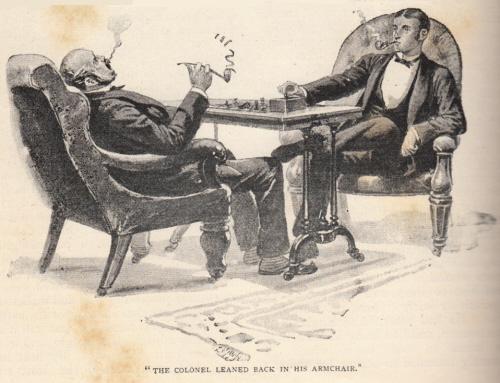
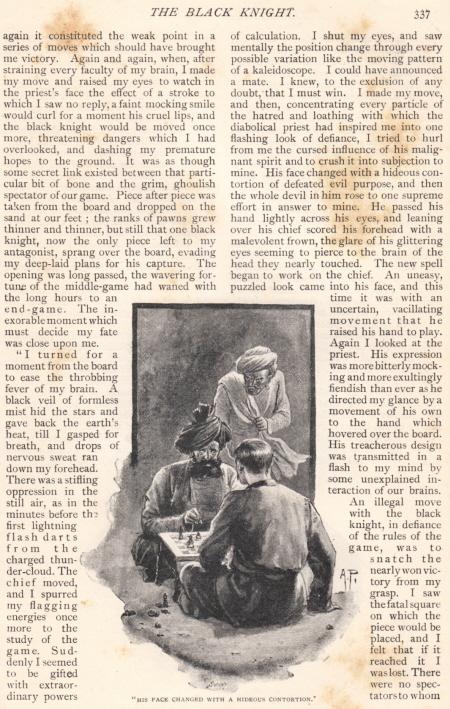
(7457)
Michael Clapham (Ipswich, England) notes that page 523 of Douglas A. Betts’ Annotated Bibliography mentioned another chess story by Raymund Allen:

We add that ‘A Happy Solution’ was subsequently anthologized on pages 234-250 of Chess in Literature by Marcello Truzzi (New York, 1974). Moreover, in the December issues of The Strand of 1913, 1914 and 1915 there were also chess stories by Allen, as reported by T.R. Dawson in his ‘Endings’ column in the Chess Amateur.
January 1914, page 109:
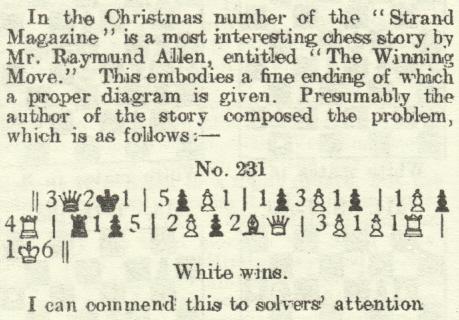
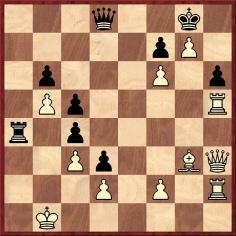
January 1915, page 113:
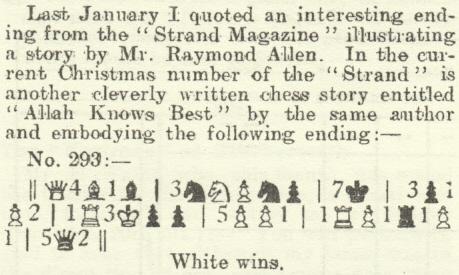
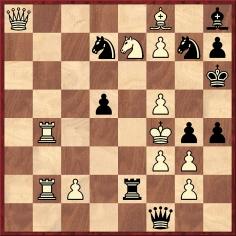
January 1916, page 111:
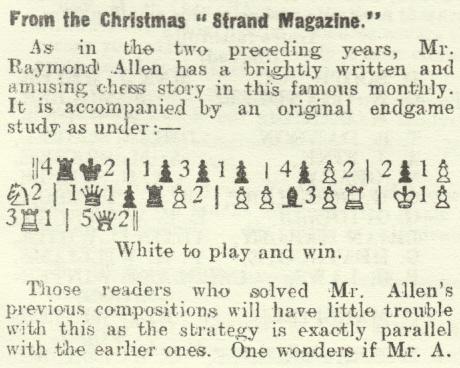

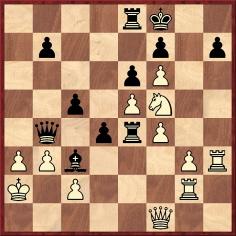
(7464)
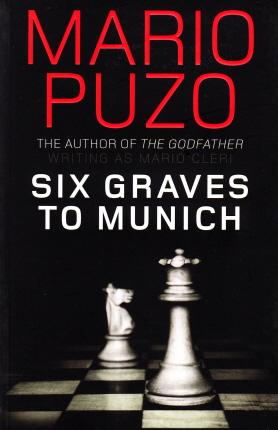
John Roycroft (London) points out a number of chess-related passages in the novel Six Graves to Munich which Mario Puzo published, under the name Mario Cleri, in 1967, two years before the appearance of The Godfather. The following comes from pages 177-178 of the 2010 paperback edition:
‘Rogan worked intently at the table for nearly three hours. He drilled a hole in the bottom of the king, and then took the bottom out entirely. Working very carefully, he hollowed out the inside of the chess piece and packed it with liquid explosive, wires, and the tiny electronic parts. When he was finished he put the bottom back on, and then with buffing cloth and enamel he hid all scratches and chips. He held the chess piece in his hand, trying to see if the extra weight was too obvious. He did notice a little difference, but he reasoned that this was because he was looking for the difference. The piece would pass.
He turned to Vrostk. “At eight o’clock tonight this thing will blow up in Pajerski’s face.”’
(7535)
Alex Gorbounov (Cary, NC, USA) draws attention to the short story by Alexander Kazantsev Тринадцатый подвиг Геракла (‘The Thirteenth Labour of Hercules’) and asks whether it has ever been translated into other languages.
(7700)
Chess is seldom depicted on the front cover of children’s books, but below is Babar’s Picnic by Laurent de Brunhoff (New York, undated):
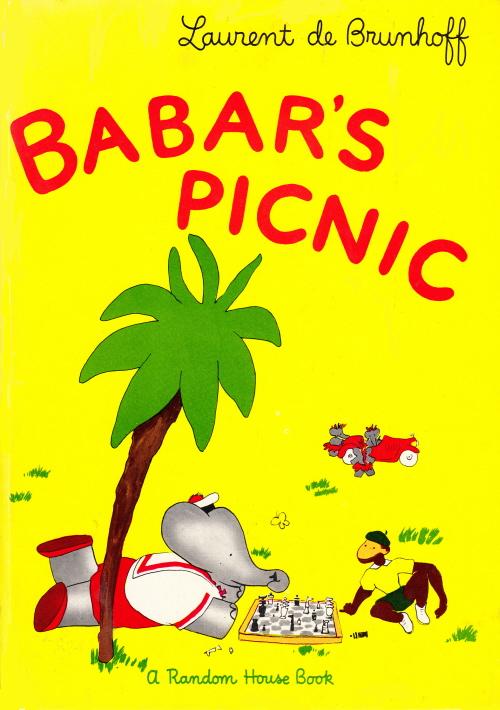
Page 11 of the story:
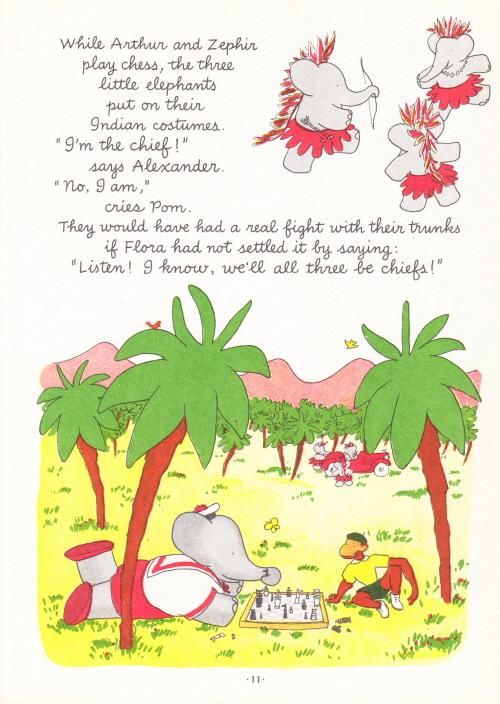
(7736)
A game by the author of Lorna Doone was published on page 114 of The Field, 31 January 1874:
Richard Doddridge Blackmore – Nelson Fedden
Correspondence (date?)
Centre Counter Game
1 e4 d5 2 exd5 Qxd5 3 Nc3 Qa5 4 Bc4 e6 5 d3 Nf6 6 Bd2 Bb4 7 a3 Bxc3 8 Bxc3 Qh5 9 Qxh5 Nxh5 10 Be5 Na6 11 O-O-O c6 12 d4 f6 13 Bg3 Nxg3 14 hxg3 b5 15 Bd3 h6 16 Bg6+ Ke7 17 Re1 Nc7 18 f4 Kd6 19 g4 Nd5 20 g3 Ne7 21 Bd3 Bb7 22 Rh2 Rae8 23 Rd2 Bc8 24 Rde2 Bd7 25 f5 exf5 26 gxf5 Nd5 27 Rxe8 Rxe8 28 Rxe8 Bxe8 29 Nf3 Bh5 30 Be4 Ne3 31 Nh2 Nc4
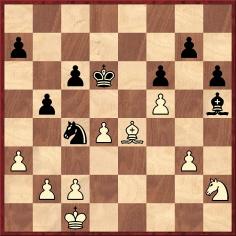
32 b3 Nxa3 33 c3 c5 34 dxc5+ Kxc5 35 b4+ Kd6 36 Bd3 Ke5 37 Nf1 Nc4 38 Nh2 a6 39 Kc2 Kd5 40 Kc1 Ne5 41 Kd2 Nxd3 42 Kxd3 Ke5 43 g4
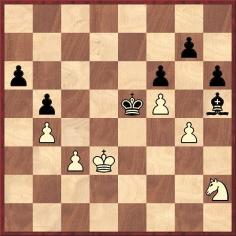
43...Bxg4 44 Nxg4+ Kxf5 45 Ne3+ Kf4 46 Nf1 h5 47 c4 bxc4+ 48 Kxc4 h4 49 Kc5 h3 50 Kb6 Kf3 51 Kxa6 Kf2 52 Nh2 Kg2 53 b5 Kxh2 54 b6 Kg2 55 b7 h2 56 b8(Q) h1(Q) 57 Qb7+ Kh2 58 Qxg7 Drawn.
From D.J. Morgan’s Quotes and Queries column on page 23 of the January 1961 BCM:
‘R.D. Blackmore on Chess. We found this in the novelist’s biography by W.H. Dunn (page 174): “The only game worth playing!”, he once said to James Baker. “Think of the genius who invented the knight’s move.” He came to know Steinitz and H.F.L. Meyer.’
(7976)
See too C.N. 7992.
Has any reader seen the 1950 production (Pulitzer Prize Playhouse) The End Game? The short story by John P. Marquand was published on pages 24-25 and 145-179 of the March 1944 issue of Good Housekeeping, and also appeared on pages 144-194 of his anthology Thirty Years (Boston, 1954).
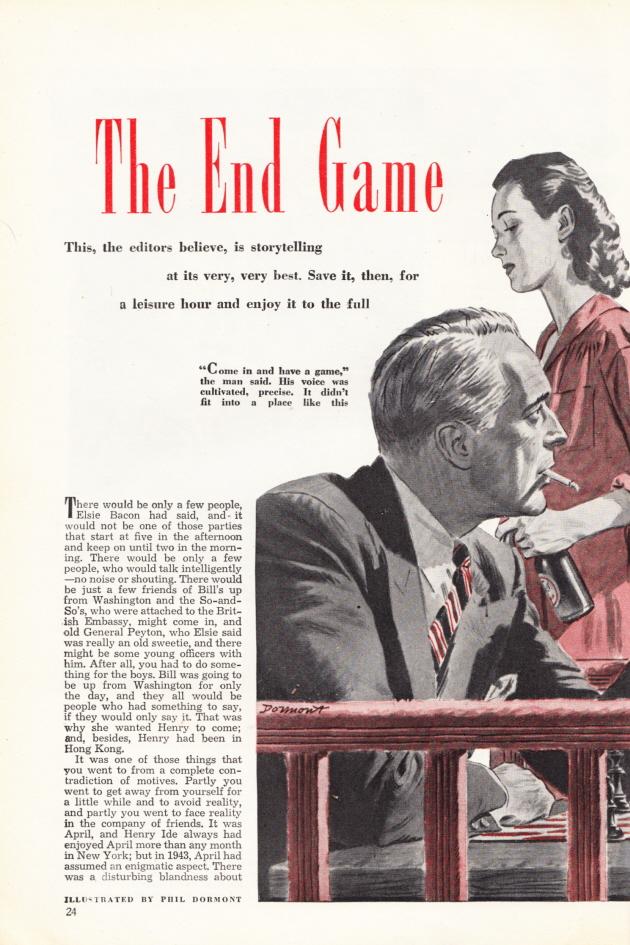
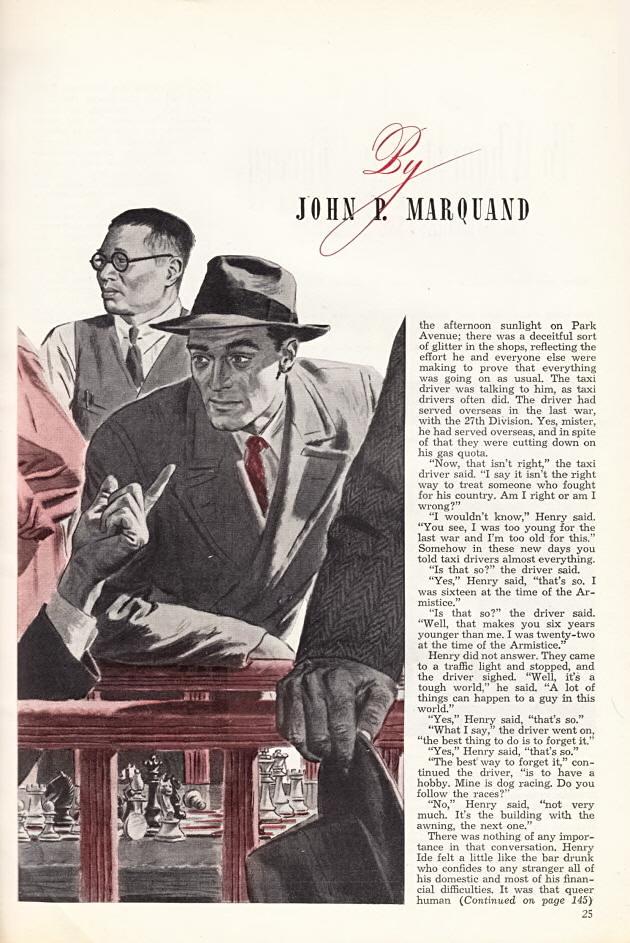
An illustrative excerpt from page 155 of Good Housekeeping:
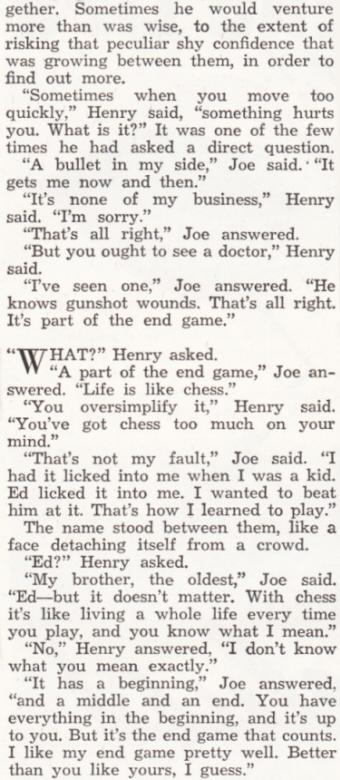
(8098)
John P. Marquand’s introductory commentary on his short story The End Game when it was anthologized on pages 144-194 of his book Thirty Years (Boston, 1954):
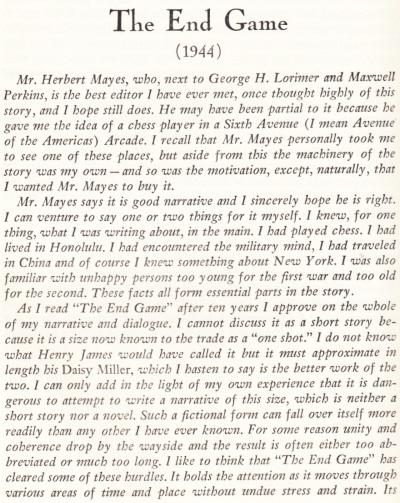

(8157)
Dominique Thimognier (Fondettes, France) submits the front cover of Le Petit Vingtième, 2 July 1936, featuring General Alcazar and Tintin in L’oreille cassée (The Broken Ear):
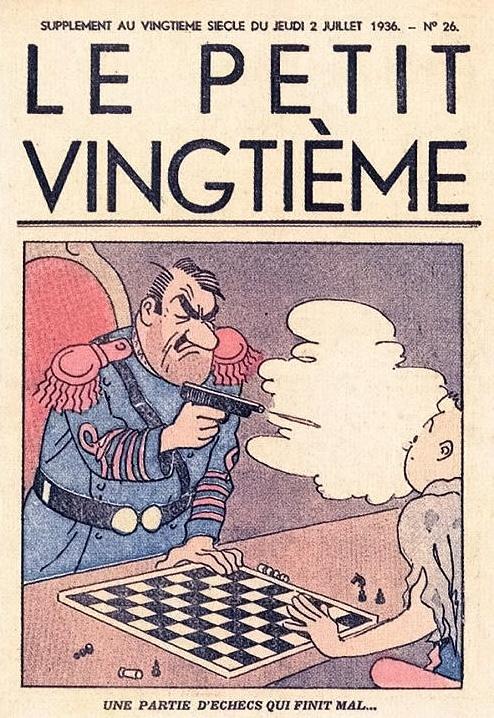
(8113)
From page 102 of CHESS, April 1941:
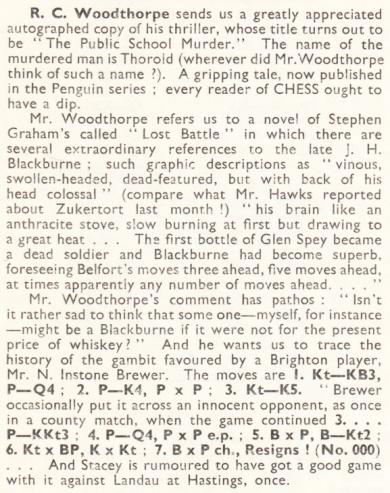
The game given (1 Nf3 d5 2 e4 dxe4 3 Ne5 g6 4 d4 exd3 5 Bxd3 Bg7 6 Nxf7 Kxf7 7 Bxg6+ Resigns) recalls the miniature (1 d4 Nf6 2 c4 e5 3 dxe5 Ng4 4 a3 d6 5 exd6 Bxd6 6 g3 Nxf2 7 White resigns) discussed in a number of items, including C.N. 7771.
We seek information about N. Instone Brewer and any game-scores involving Stacey and Landau. They met in the Premier Reserves (Section I) at Hastings, 1935-36 (BCM, February 1936, page 52), but the moves have not been found.
As regards the novel Lost Battle by Stephen Graham (London, 1934), we have an inscribed copy:
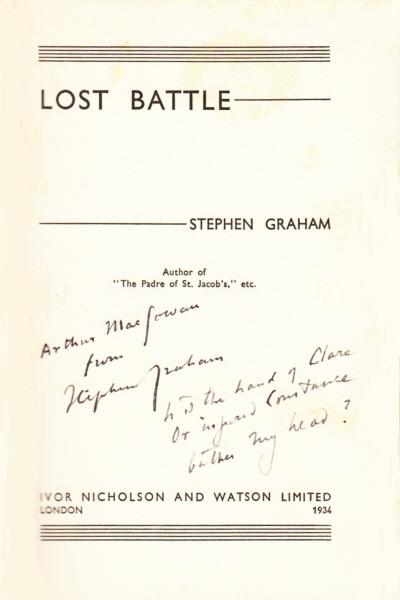
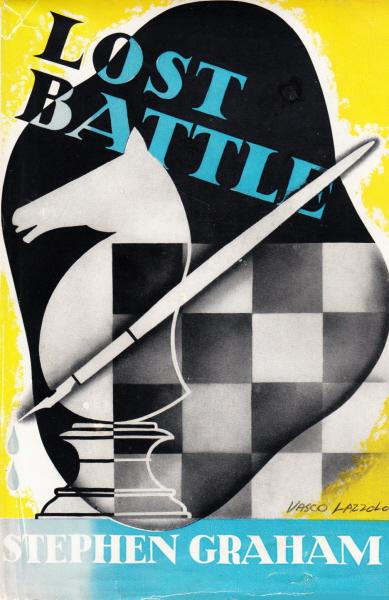
Chess is mentioned in the first paragraph and regularly throughout the book. There are many references to old players, and Blackburne in particular. Two sample pages:
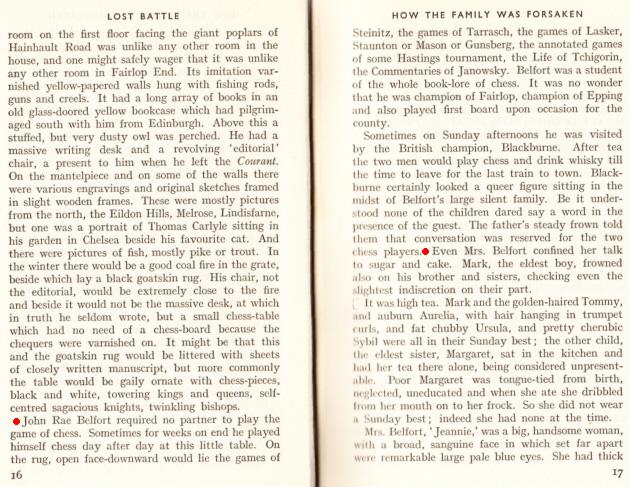
(8380)
Chess authors often write fiction, but Jeremy Silman has done so intentionally with a novel, Autobiography of a Goat (Los Angeles, 2013):
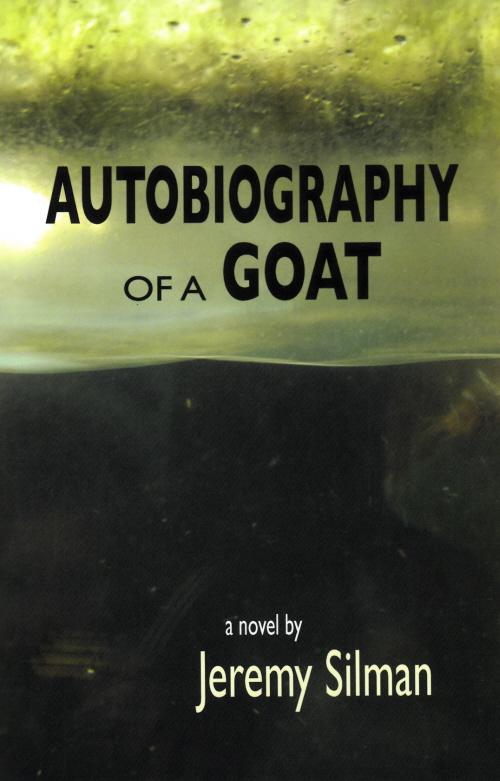
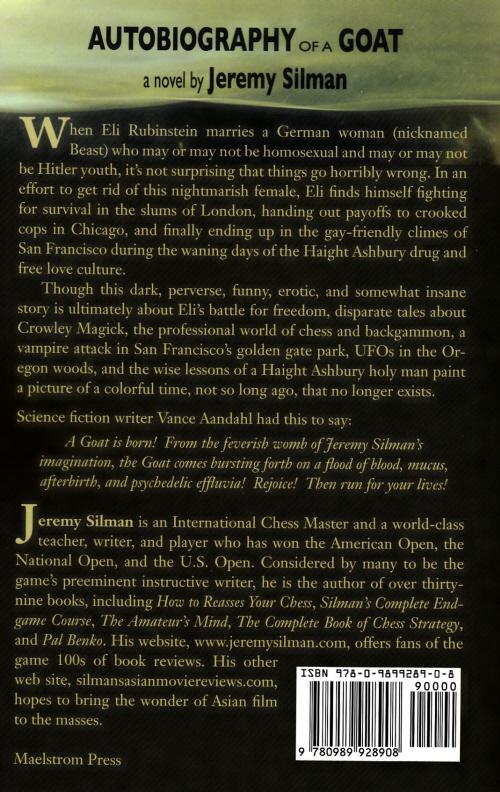
(8562)
From Oliver Beck (Seattle, WA, USA):
‘In Julien Gracq’s Un beau ténébreux (Paris, 1945) a character’s chess is described as follows:
“Il joue remarquablement, avec une prédilection pour les parties fermées, la Sicilienne, l’Ouest-Indienne, comme tous les joueurs qui sentent ces relations secrètes de case à case qui sommeillent sur l’échiquier, cette puissance explosive latente qui dort dans chaque pièce, et dont l’appréhension intuitive fait toute la supériorité du jeu de fakirs, comme Alekhine, comme Breyer, comme Botwinnik, sur les géomètres [Gracq’s emphasis] de l’échiquier qu’étaient un Morphy ou un Rubinstein” (pages 67-68 in the 1983 José Corti edition).
This description, with the somewhat surprising insertion of Breyer between Alekhine and Botvinnik, may be better understood in light of Gracq’s comment in Lettrines 2 (Paris, 1974):
“... puis, en 1929, le livre de Réti: Modern Ideas in Chess, qui est un peu le Manifeste du Surréalisme échiquéen, me donna à Londres tout un été de découverte et de bonheur” (page 176 in the 1978 José Corti edition).
Elsewhere in Lettrines 2, Gracq describes an encounter with E. Znosko-Borovsky:
“Une fois, avec le président du cercle d’échecs de Quimper, nous y conduisîmes Znosko-Borovsky, célèbre joueur d’échecs, que nous avions invité dans notre ville pour une conférence et une séance de simultanées; avec sa moustache taillée en brosse, il avait l’air d’un gentil et courtois bouledogue. Je ne sais pourquoi je le revois encore parfaitement, silhouetté au bord de la falaise, regardant l’horizon du Sud: il y avait dans cette image je ne sais quoi d’incongru et de parfaitement dépaysant. Il ne disait rien. Peut-être rêvait-il, sur ce haut lieu, à la victoire qu’il avait un jour remportée sur Capablanca” (page 38).
Gracq’s reference to Capablanca v Znosko-Borovsky, St Petersburg, 1913 may not seem unusual; it was annotated in the illustrative games section of Capablanca’s Chess Fundamentals and touched upon in Chapter VII of My Chess Career. However, it causes me to wonder whether Znosko-Borovsky ever mentioned it in his writings. Also, considering Capablanca’s incredible success during his second European tour, how much attention was paid to Znosko-Borovsky’s victory at the time?’
(8631)

The chess novel White Death by Daniel Blake (London, 2012) has 64 chapters divided into three parts:
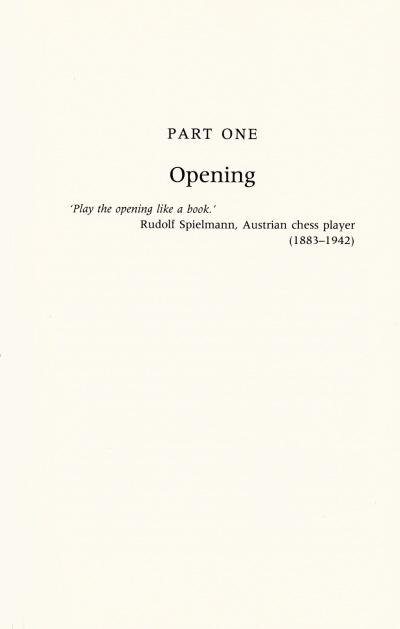
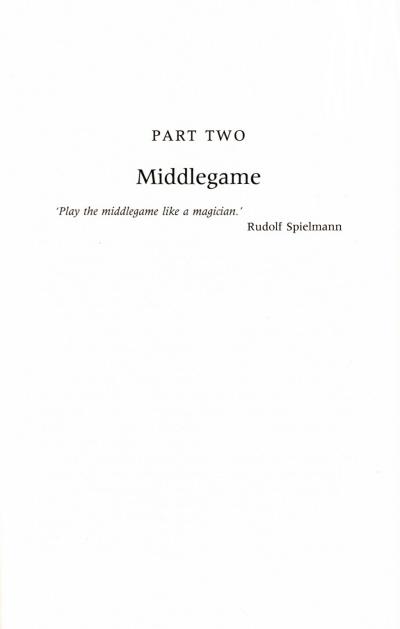
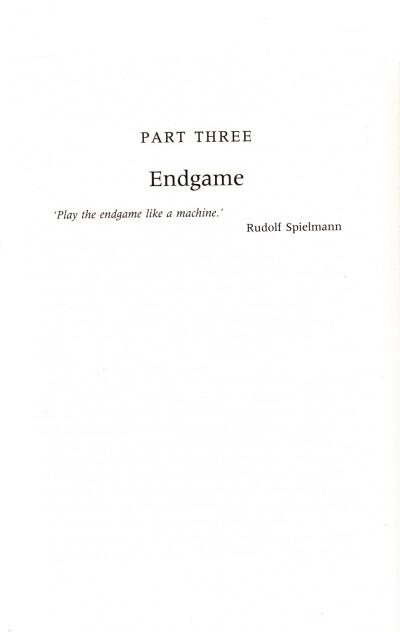
How many more times will the nineteenth-century quote be misattributed to Spielmann?
(8832)
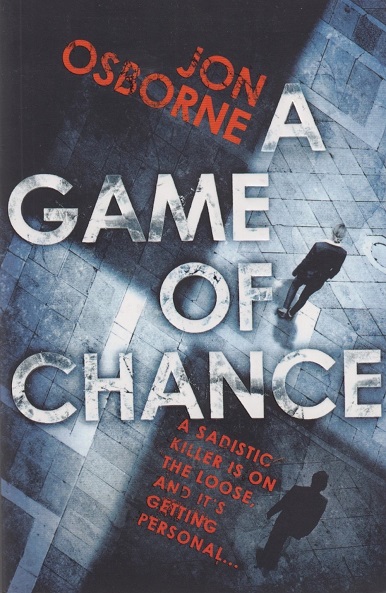
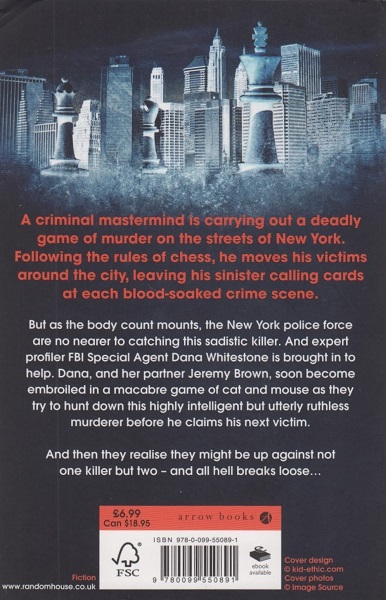
A Game of Chance by Jon Osborne (London, 2012) has many references to Richard Forster’s book on Amos Burn. See pages 26-27, 46, 66, 159, 224 and 227.
(9040)
The front-cover photograph in the January 1952 Chess Review:
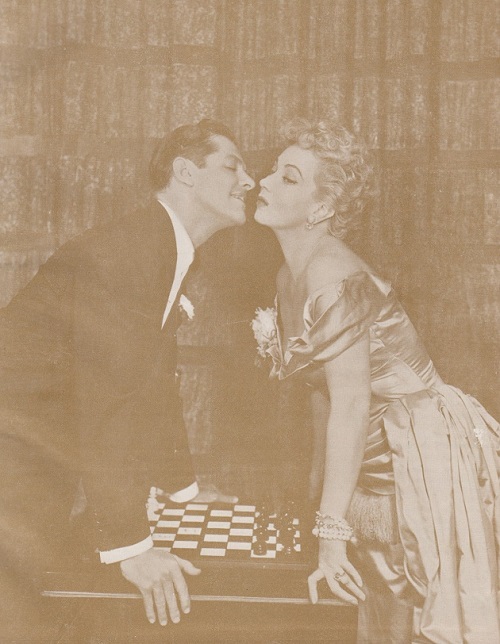
Robert Cummings and Ann Sothern
From page 4 of the magazine:
‘Faithfully Yours was the play which featured chess – more than is apparent from our cover picture – for 1951.
It also had quips at psycho-analysis, gorgeous gowns for Ann Southern [sic] and comic antics by Robert Cummings.
It seems that Ann played a daily game with hubby, Bob; but, after ten years, still lost her queen in “that trap in the Tchigorin Variation”. So hubby finally couldn’t stand it any longer.
He blows his top. The psycho-analyst enters. But he doesn’t teach Ann how to play chess either – the cad.’
Faithfully Yours was written by L. Bush-Fekete and Mary Helen Fay.
(9101)
Regarding the play Faithfully Yours we have acquired a playbill dated October 1951. Dominated by cigarette advertisements (Vivian Blaine: ‘A singer must think of her throat. I’ve found the cigarette that suits my throat best is Camel.’ Dennis James: ‘If you want a treat instead of a treatment ... treat yourself to Old Golds.’), the playbill has nothing of interest about Faithfully Yours except some basic information:
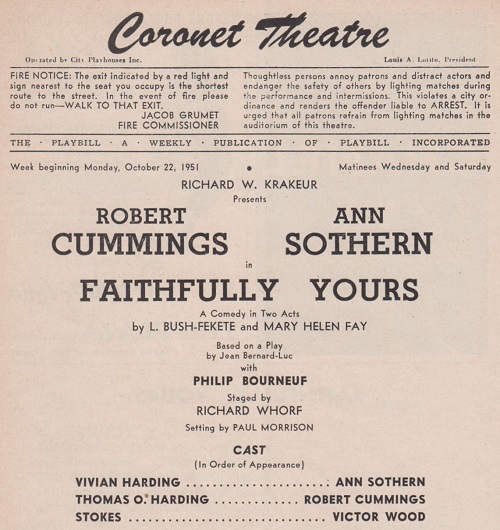
The play by Jean Bernard-Luc is Le complexe de Philémon, a three-act comedy first performed at the Théâtre Montparnasse-Gaston Baty in Paris on 10 December 1950. The text was published the following year:
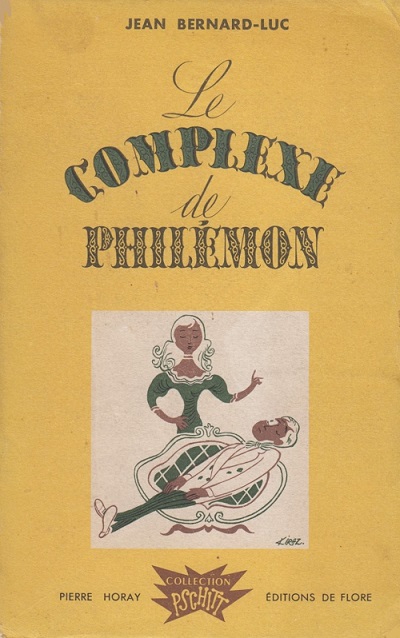
From the back cover:
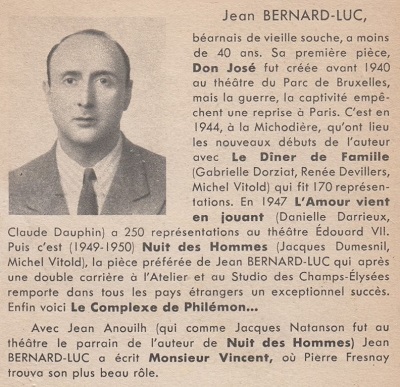
The chess content of Le complexe de Philémon is essentially limited to the throwing of chess pieces. An example:
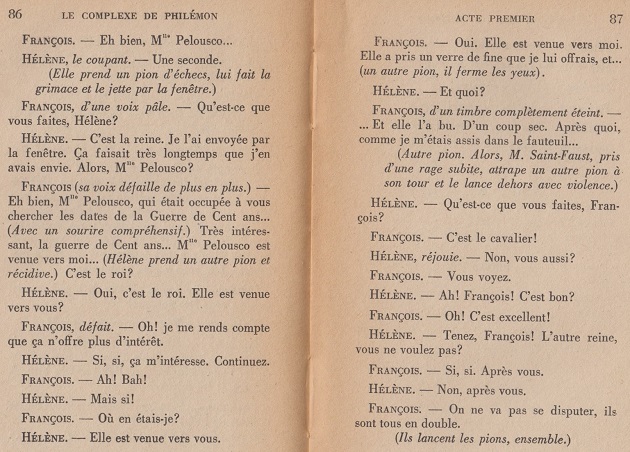
Le complexe de Philémon was also the basis for ‘a farcical comedy’, The Happy Marriage by John Clements, produced at the Duke of York’s Theatre in London on 7 August 1952 and published the following year by Samuel French. Below is a page from that ‘acting edition’:
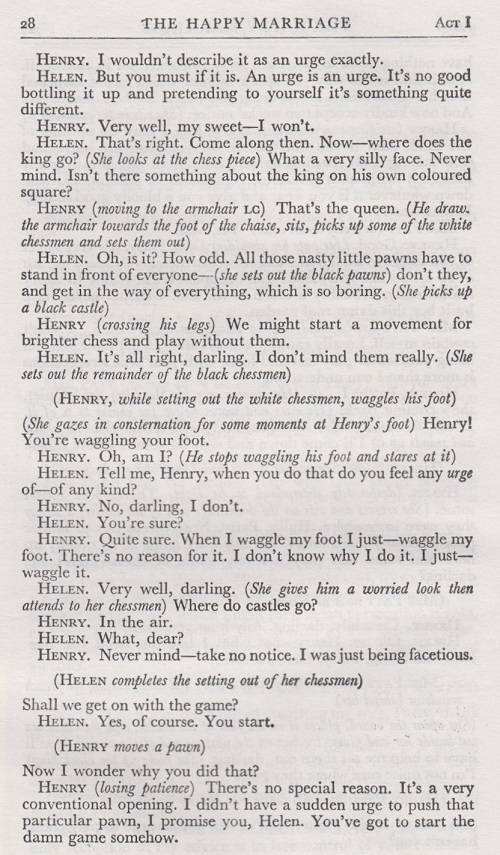
The text of Faithfully Yours has not yet been found.
(9174)
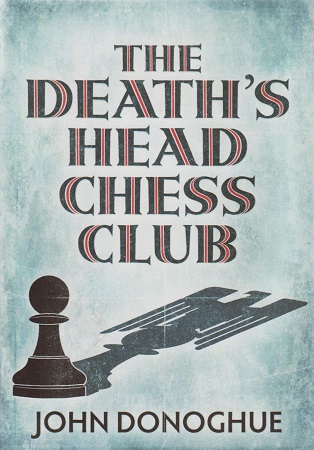
The inside front flap of the dust-jacket:
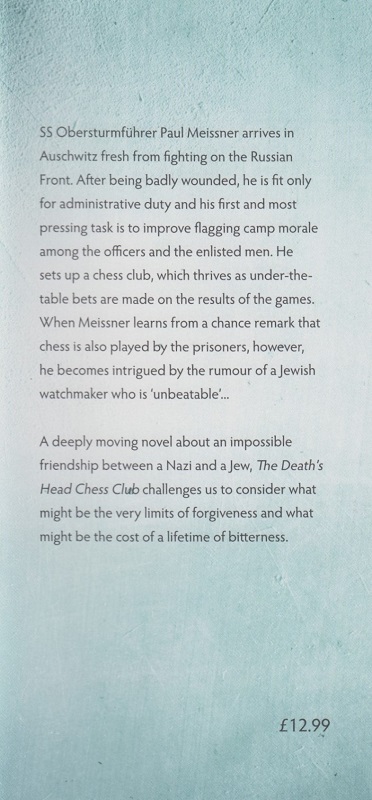
Page 383 of John Donoghue’s novel states: ‘Most of the chapter headings relate to chess moves. The moves were chosen to reflect some aspect of the chapter content.’
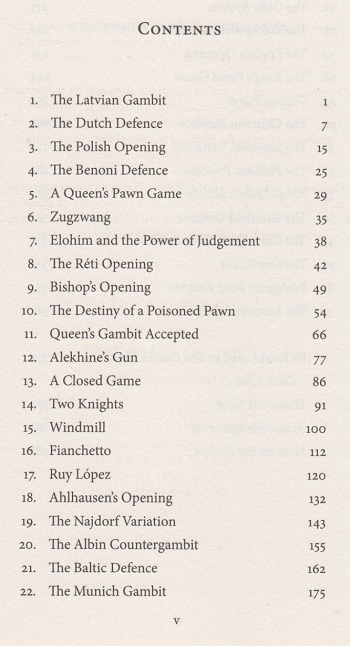
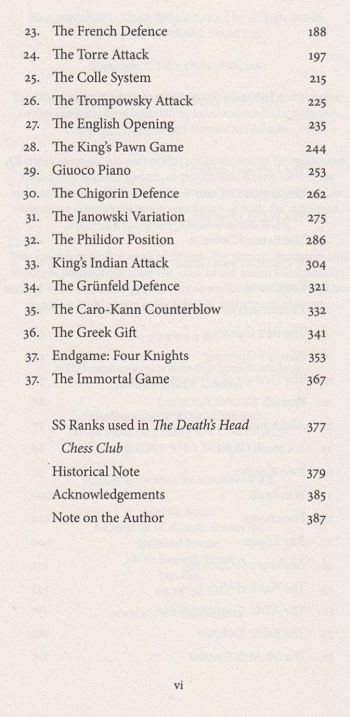
(9202)
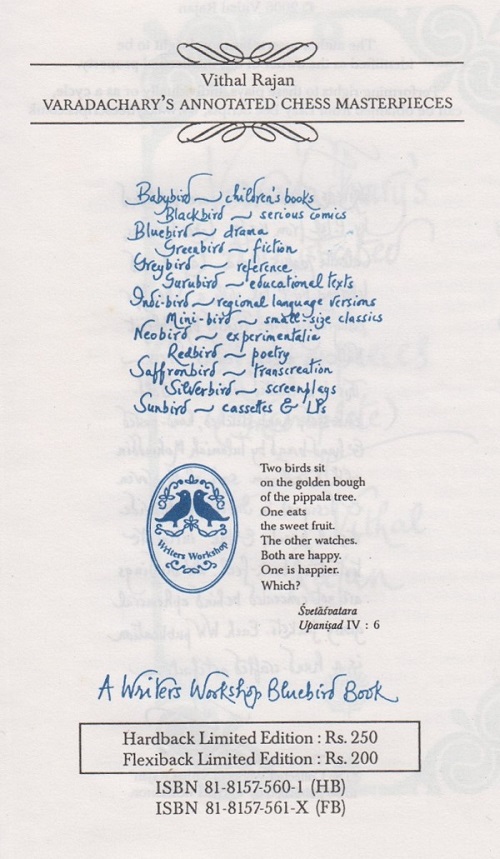
Varadachary’s Annotated Chess Masterpieces (Incomplete) by Vithal Rajan (2006) comprises 11 playlets, and a sample page from the first one, ‘Alekhine’s Greatest Defeat’, should suffice:
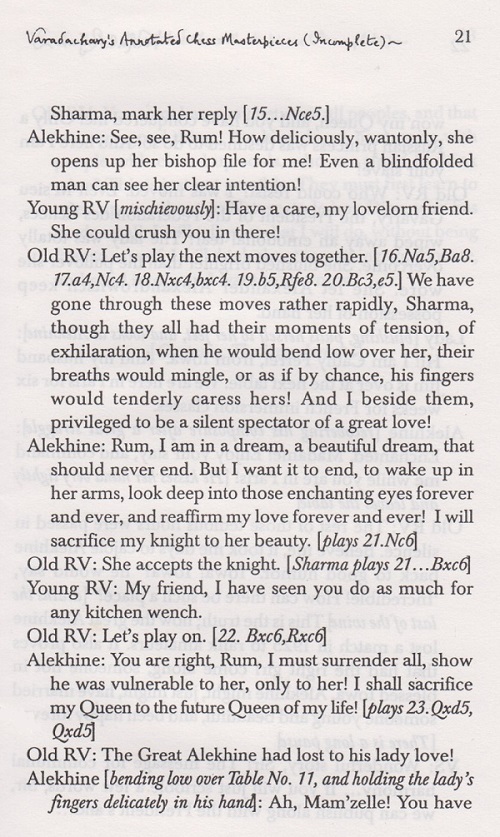
(9310)
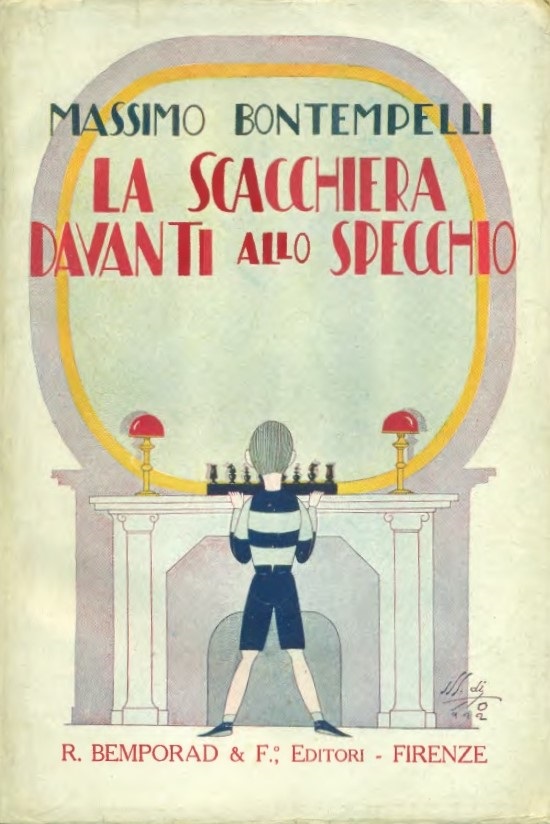
From Oliver Beck:
‘In Massimo Bontempelli’s La scacchiera davanti allo specchio (Florence, 1922), a children’s book with similarities to Through the Looking Glass, a child enters a mirrored world where he is told of the importance of chess pieces by a reflected white king:
“... e devi sapere che i pezzi degli scacchi sono molto molto più antichi degli uomini: molti secoli dopo che c’erano gli scacchi sono nati gli uomini, che sono all’ingrosso una specie di pedoni, con i loro alfieri, re e regine; e anche i cavalli, a imitazione dei nostri. Allora gli uomini hanno fabbricato delle torri per fare come noi. Hanno poi fatto anche molte altre cose, ma quelle sono tutte superflue. E tutto quello che accade tra gli uomini, specialmente le cose più importanti che si studiano poi nella storia, non sono altro che imitazioni confuse e variazioni impasticciate di grandi partite a scacchi, giocate da noi. Noi siamo gli esemplari e i governatori dell’umanità.” (Pages 98-101.)
In La donna del Nadir (Rome, 1924) Bontempelli returned to the history of chess in a short essay entitled “Clima sacro”. Commenting on a report of a ten-board blindfold exhibition by Alekhine in Milan, and after suggesting that this achievement was made possible only by Alekhine’s ability to operate outside of any human faculty, Bontempelli offered the following:
“Non senza ragione del gioco degli scacchi non si conosce l’origine: esso probabilmente preesisteva all’apparizione dell’uomo sulla terra, e forse anche alla creazione del mondo; e se il mondo ripiomberà nel caos, e il caos si ridissolverà nel nulla, il gioco degli scacchi rimarrà, fuori dello spazio e del tempo, partecipe dell’eternità delle Idee.” (Page 60.)
On page 186 of the Skinner/Verhoeven book on Alekhine there is an account of his ten-board blindfold exhibition in Milan on 25 March 1923, and the following page shows two games from the event: a spirited win by Luca Morelli, referred to in C.N. 6903, and a loss by Giuseppe Padulli. The Padulli game also appears on page 120 of L’antica Storia della Società Scacchistica Milanese dal 1881 agli anni ’60, volume 1 by Alessandro Sanvito (Bologna, 2014). However, there it is recorded as a draw after 50 Rc2 (instead of 50 Kc2 h5 and resigns, which indicates a double blunder).
The Sanvito book states too (page 62) that Alekhine visited the Società Scacchistica Milanese and faced 14 opponents in a simultaneous blindfold exhibition at the salons of the Società Artisiti e Patriottica, winning each game. No date is given.
Estelle Gilson has produced an English translation of La scacchiera davanti allo specchio, with original illustrations: The Chess Set in the Mirror (Philadelphia, 2007).’
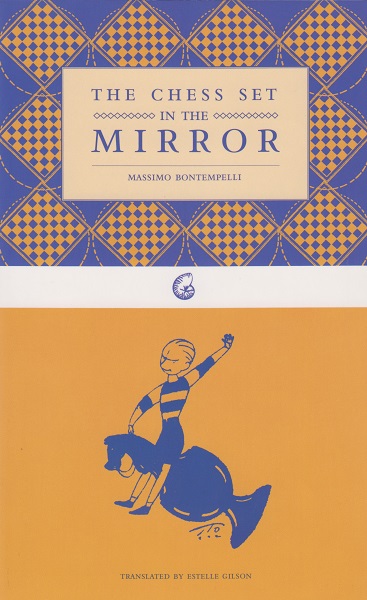
(9629)
Claus Montonen (Helsinki) is seeking information about literary works which take real chess events as their subject, his request being prompted by the play Reikiavik by Juan Mayorga (Segovia, 2015). Below are the front and back covers, as well as two sample pages:
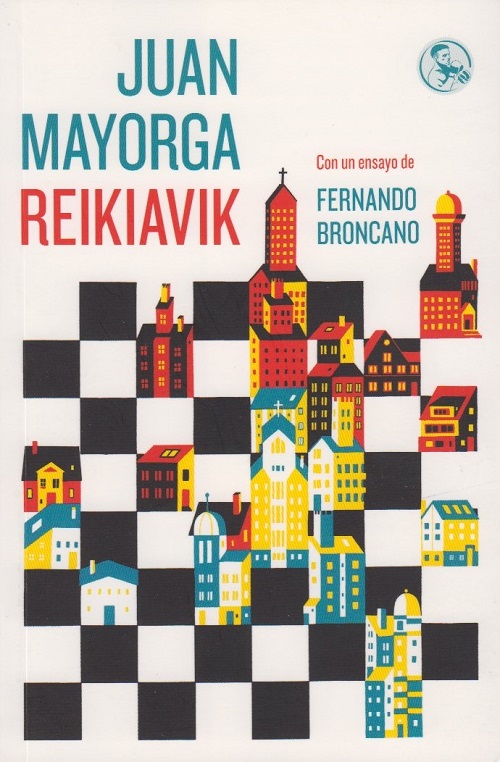
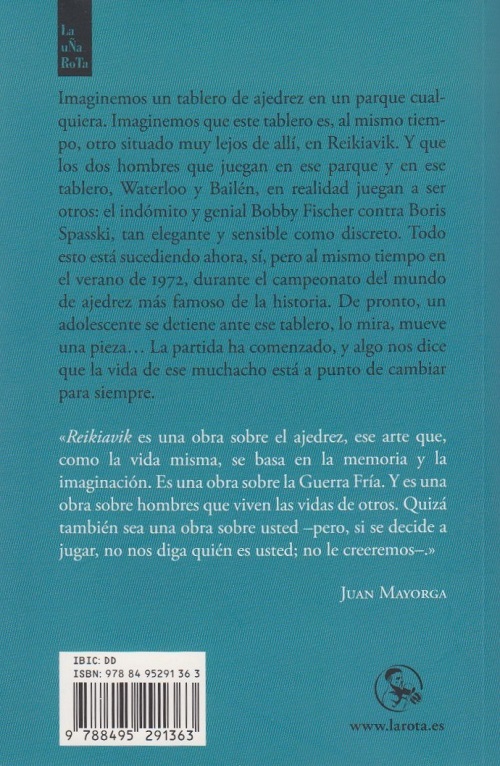
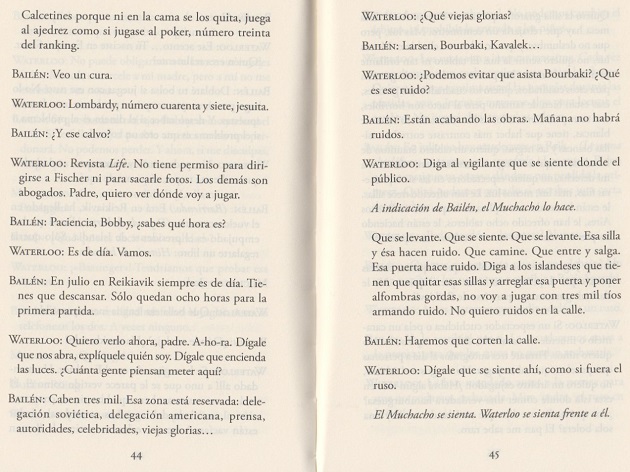
(9641)
C.N. 9641 referred to a play in Spanish concerning the 1972 world chess championship match. Another work is Einvígid by Arnaldur Indriðason (Reykjavik, 2011). We also have the translations of the novel from Icelandic into German and French, Duell (Cologne, 2014) and Le duel (Paris, 2014).
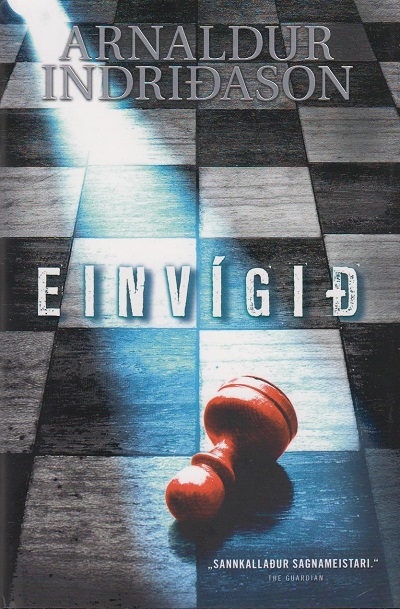

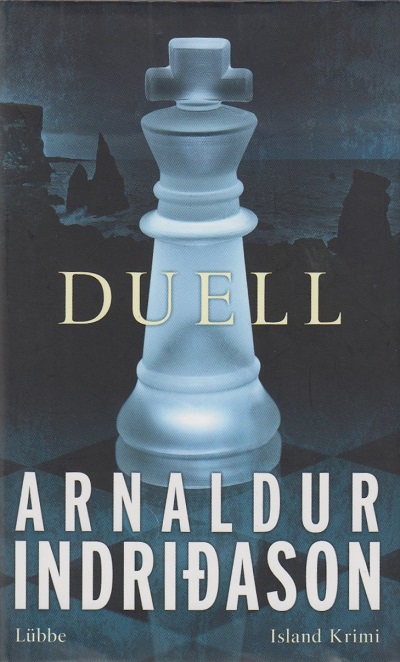
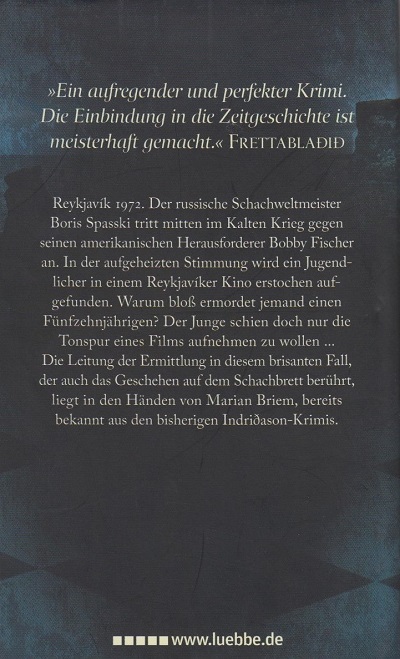
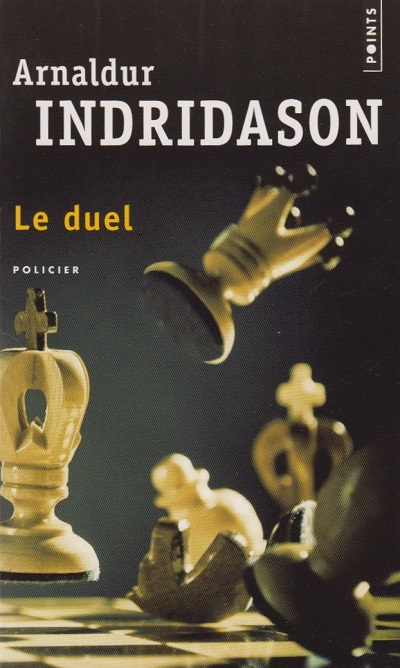
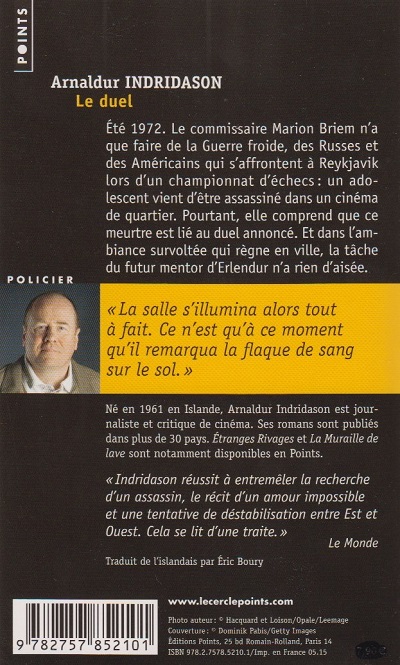
(9761)
From page 2 of issue one of Chess Pie (1922):
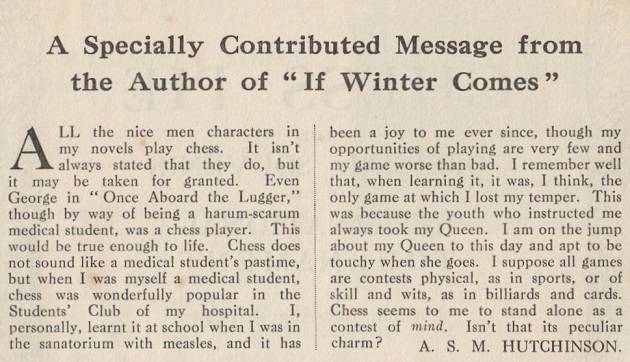
The passage was reproduced on page 141 of Chess Review, June 1935 and quoted in abridged form by Edward Lasker on page xxii of The Adventure of Chess (New York, 1950).
Arthur Stuart-Menteth Hutchinson (1879-1971) was a very popular writer, as indicated by the imprint page of our copy of If Winter Comes, published by Little, Brown and Company, Boston, 1921:
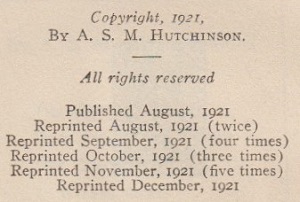
The novel has a few references to chess, as on pages 66 and 67:
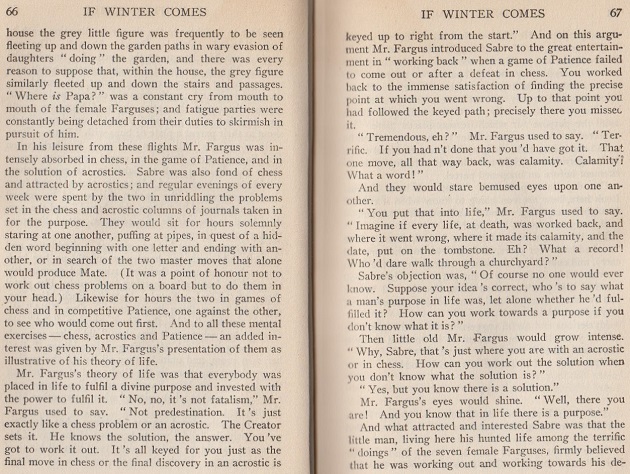
(9800)
Noting another novel featuring the 1972 world championship match,
Åttenderaden
by Arne Danielsen (Oslo, 2002 and 2014), Aðalsteinn Thorarensen
(Reykjavik) comments:
‘The main character is Herold, who grows up in Oslo, and there is a great deal of chess content (at school and in junior tournaments). Herold follows Bobby Fischer’s career and by chance is in Iceland for a club event during the Spassky v Fischer world title match.’
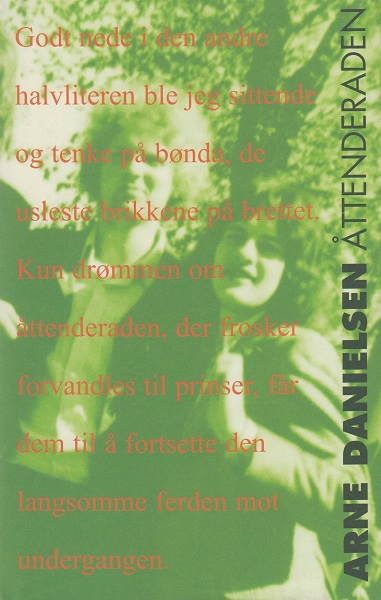
The original hardback edition (2002)
Danielsen is also the author of Mesteren Magnus Carlsen og sjakkspillet (Oslo, 2010). From the dust-jacket:
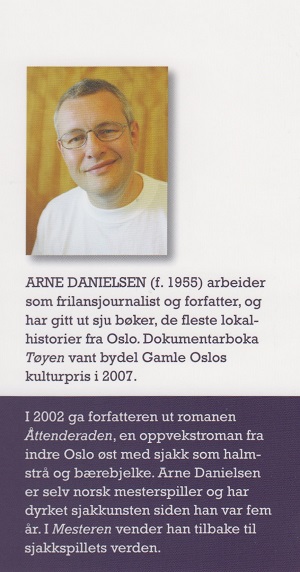
(10339)
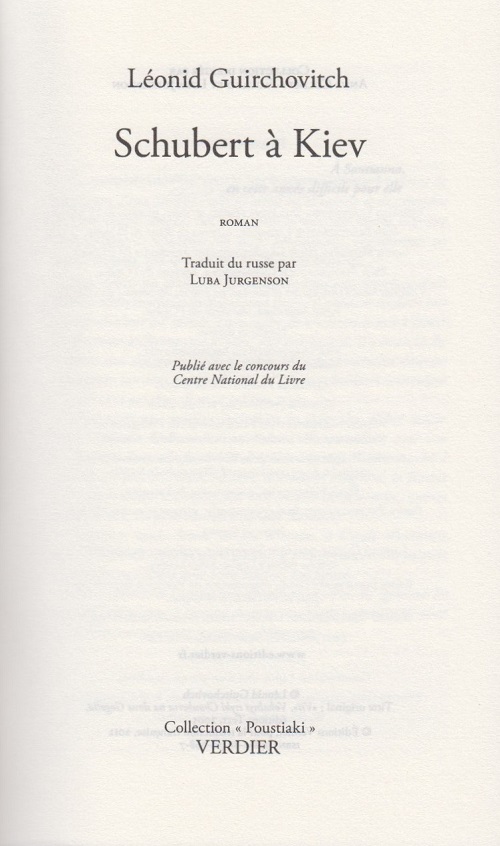
Alain Pallier (Lauris, France) notes that a character in Schubert Kiev by Léonid Guirchovitch (Lagrasse, 2012) is ‘Fiodor Parfenievitch Bogatyrtchouk, gériatre et maître d’échecs’ (page 8). His wife Irina is also featured. See, in particular, pages 17, 73-74, 108-109 and 243-250.
From page 108:
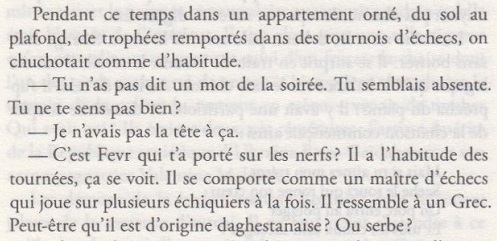
(9696)
We now also have the Russian original (Moscow, 2005):
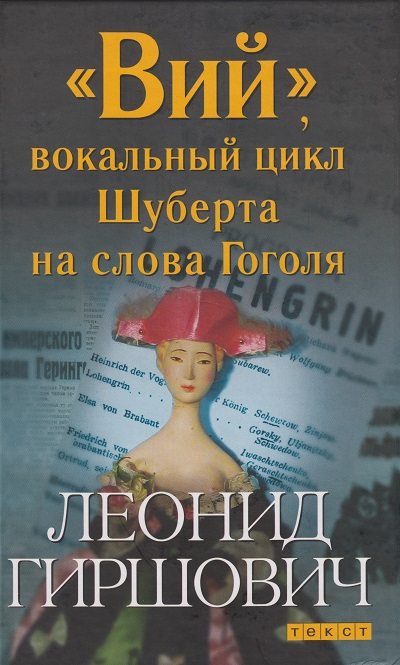
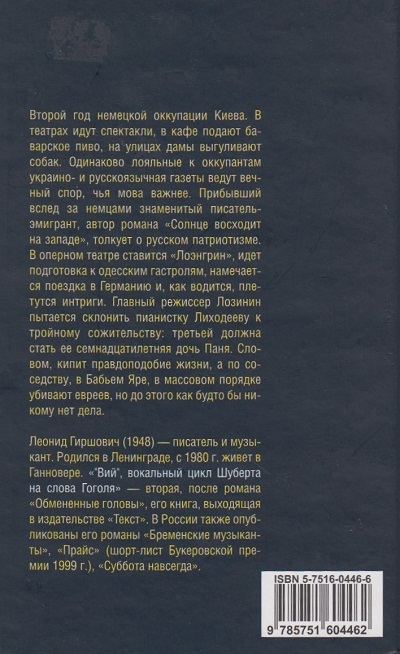
(9733)
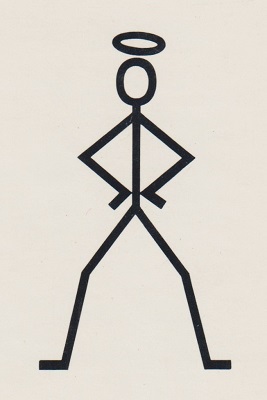
‘And the best way to refute a gambit is to accept it.’
That observation occurs in The Pawn Gambit on page 158 of Send for the Saint by Leslie Charteris (London, 1977):
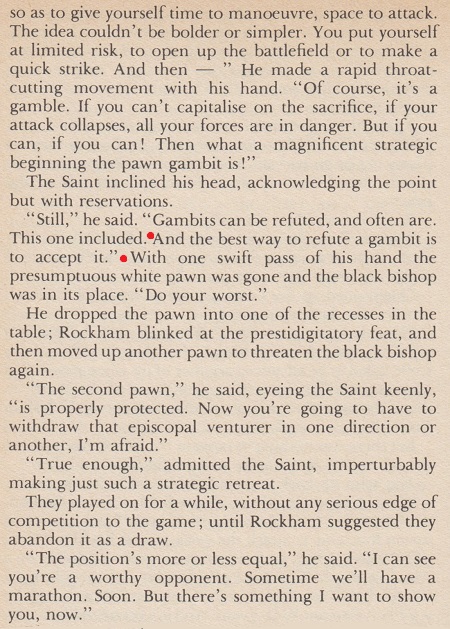
In a description of an Evans Gambit game the previous page had references to ‘the Göttingen manuscript of 1490’, ‘Bird, Blackman, Staunton, Anderssen’ and ‘Morphy, Steinity’.
The Pawn Gambit (the title The Pawn Gamble can also be found) was not written by Charteris. The contents page of Send for the Saint specified ‘Original Teleplay by Donald James’ and ‘Adapted by Peter Bloxsom’. The corresponding television episode, starring Roger Moore as Simon Templar, was ‘The Organisation Man’ (1968).
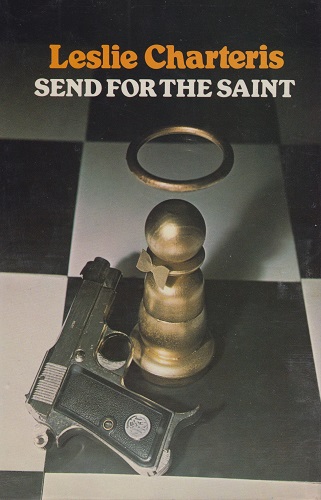
(9952)
Page 16 of La Stratégie, January 1924 had a notice concerning La Variante F. VIII du Gambit Camulogène by Edouard Pape (Paris, undated):
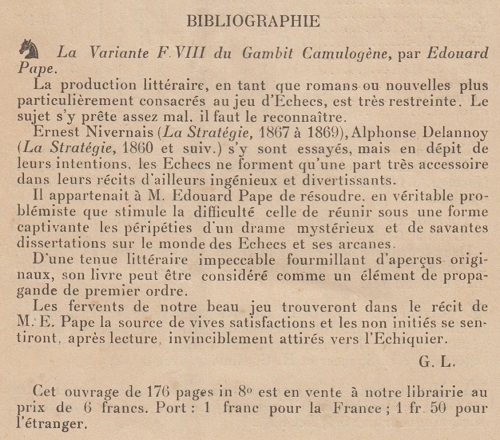
A few pages from our copy of this scarce novel:
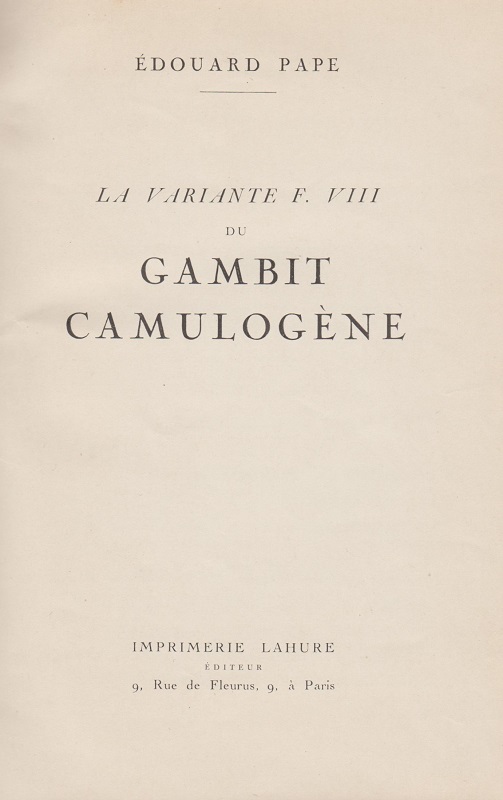
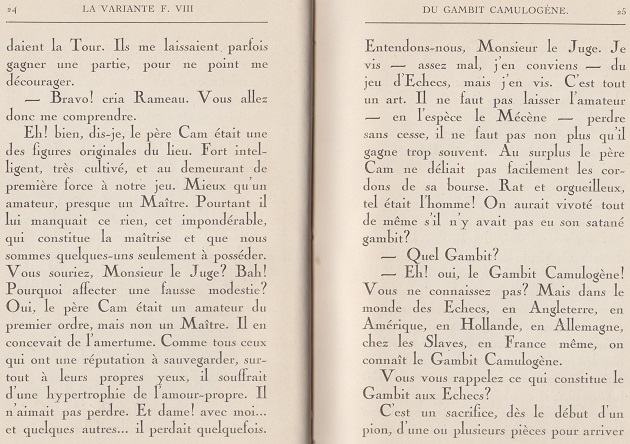
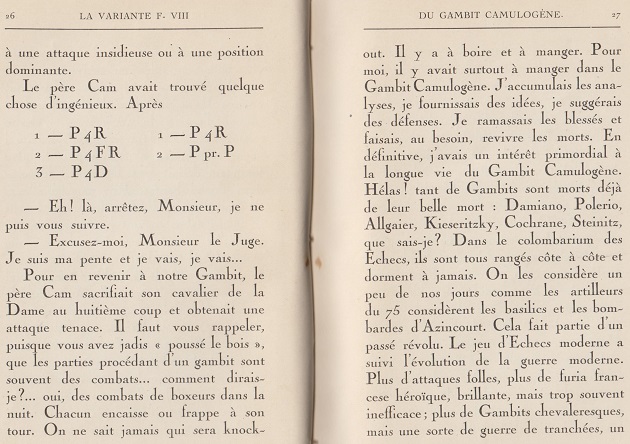
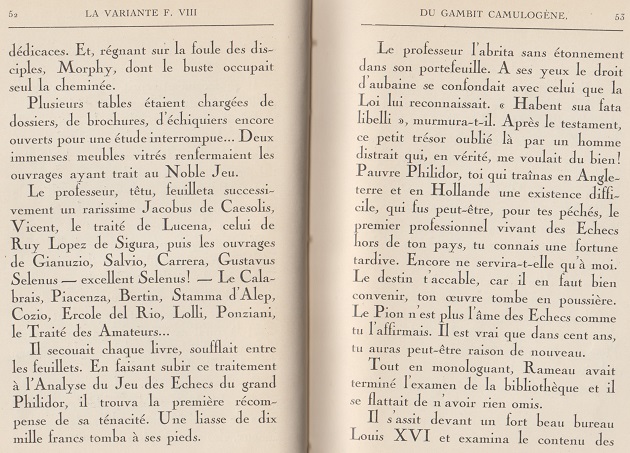
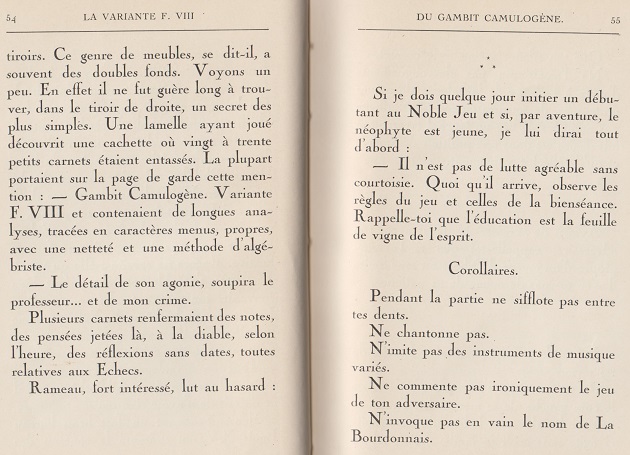
(9961)
Concerning Philidor in fiction, see C.N. 10876.
Bob van de Velde (Amsterdam) draws attention to a passage about Emanuel Lasker in the 2010 novel Field Grey by Philip Kerr. Page numbers vary from one edition to another, but the text is at the start of the chapter entitled ‘Berlin, 1954’:
‘Most people go through life accumulating possessions. I seemed to have gone through mine losing them or having them taken away from me. The only thing I still had from before the war was a broken chess piece made of bone – the head of a black knight from a Selenus chess set. During the last days of the Weimar Republic this black knight had been constantly in use at the Romanisches Café, where, once or twice, I’d played the great Emmanuel [sic] Lasker. He’d been a regular at the café until the Nazis obliged him and his brother [sic – Berthold Lasker died in 1928] to leave Germany for ever, in 1933. I could still picture him crouched over a board with his cigarettes and cigars and his Wild West moustache. Generous to a fault, he would give out tips or play exhibitions for anyone who was interested; and on his last day in the Romanisches Cafe – he went to Moscow, and then to New York – Lasker presented everyone who was there to wish him goodbye with a chess piece from the café’s best set. I got the black knight. The way I’d been played over the years I sometimes think a black pawn would have been more appropriate. Then again, a knight, even a broken one, seems intrinsically more valuable than a pawn, which was probably why I tried so hard to keep it through one adversity after another.’
(11195)
From page 29 of CHESS, November 1945:

Abrahams replied on page 52 of the December 1945 issue:
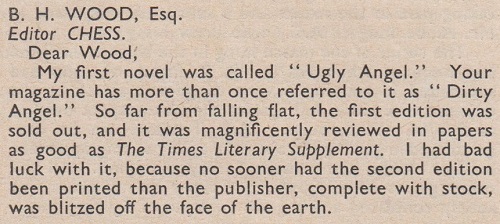
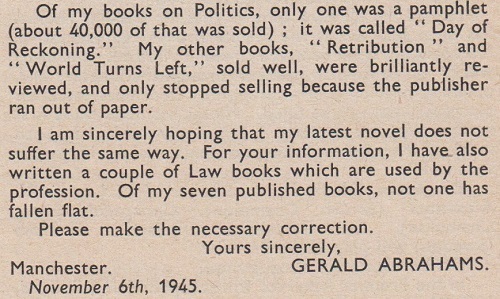
(11435)
‘The Dragon Variation is unique among novels – unique in that its sole theme is chess, which figures on virtually every page. The only comparisons that can be drawn are with Ellison’s Master Prim and Nabokov’s The Defence, which tells the story of the life’s failure and eventual suicide of a grandmaster. But Anthony Glyn’s subtly constructed plot is far more probable than either of those, and his writing displays many touches of instant humour somewhat lacking in the others.’
Source: page 70 of King, Queen and Knight by N. Knight and W. Guy (London, 1975). Pages 69-73 gave extracts from the novel.
From the inside front cover of CHESS, November 1969:

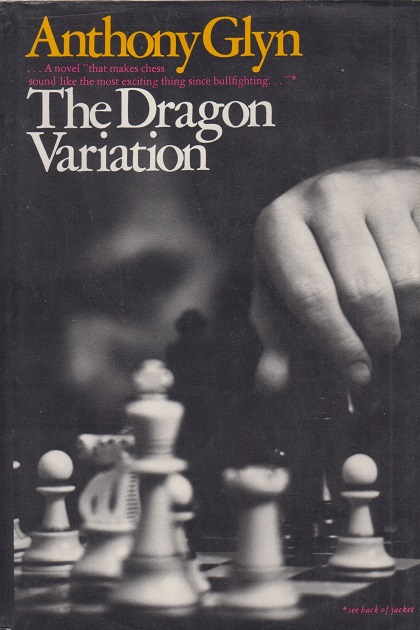
The citation on the front of the dust-jacket comes from The Times (Saturday Review), 14 June 1969, page 22, where Roger Baker wrote:
‘Mr Glyn has achieved what would seem (to me at least) impossible, and that is making chess sound like the most exciting thing since bull-fighting.’
Also from the dust-jacket:
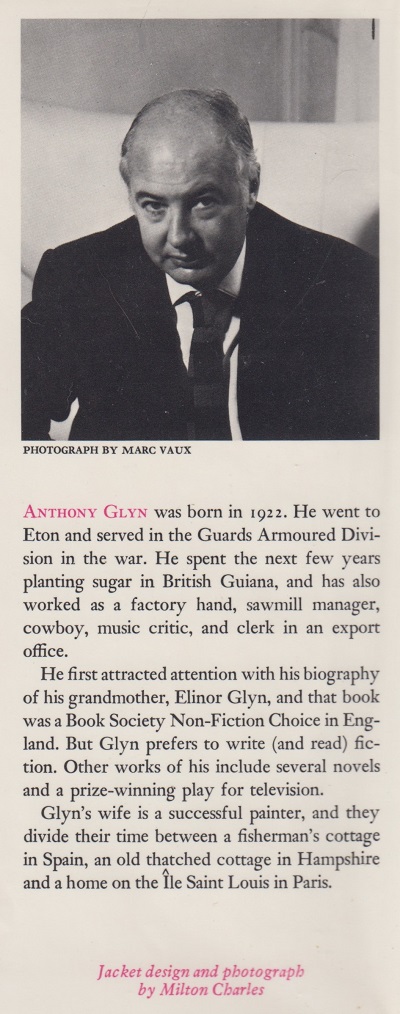
Below are three sample pages:
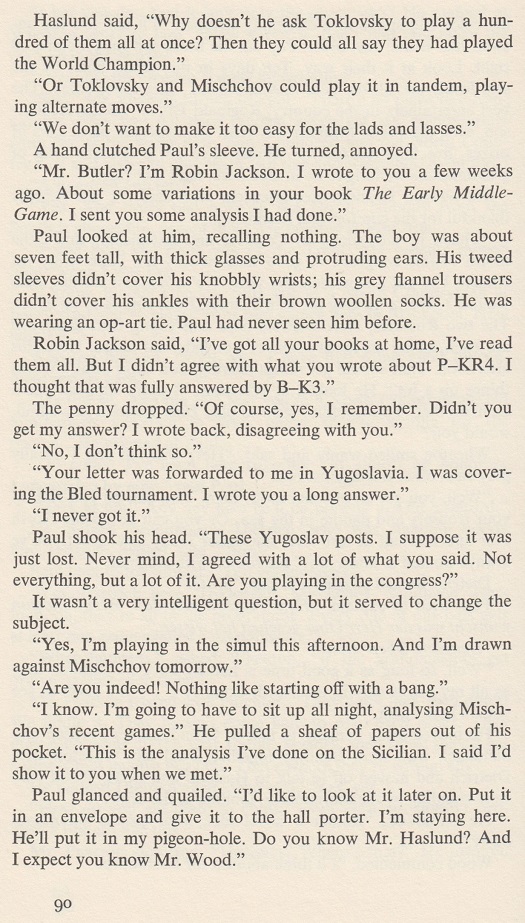
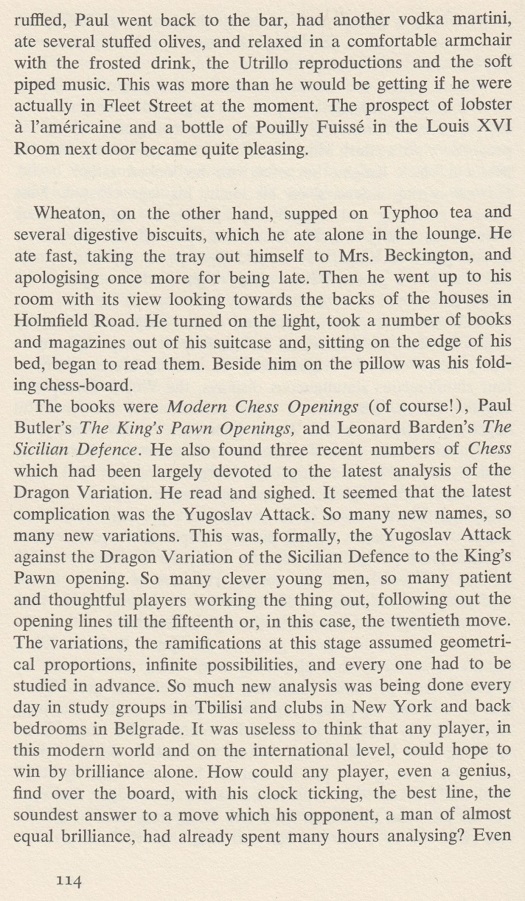
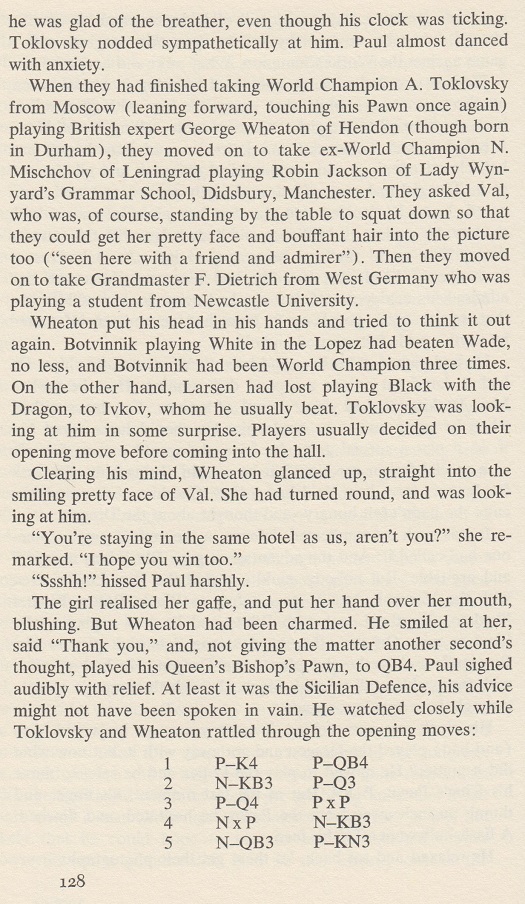
From B.H. Wood’s chess column in the Illustrated London News, 31 May 1969, page 38:
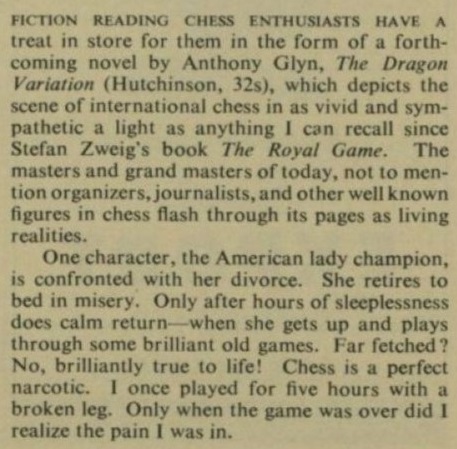
Page iv of the End-June 1969 issue of CHESS had this assessment:
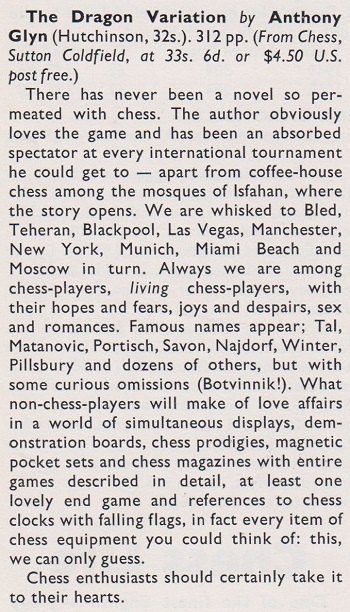
The reference to Botvinnik is incorrect; his name appears many times in the novel, including, as shown above, on page 128.
(11503)
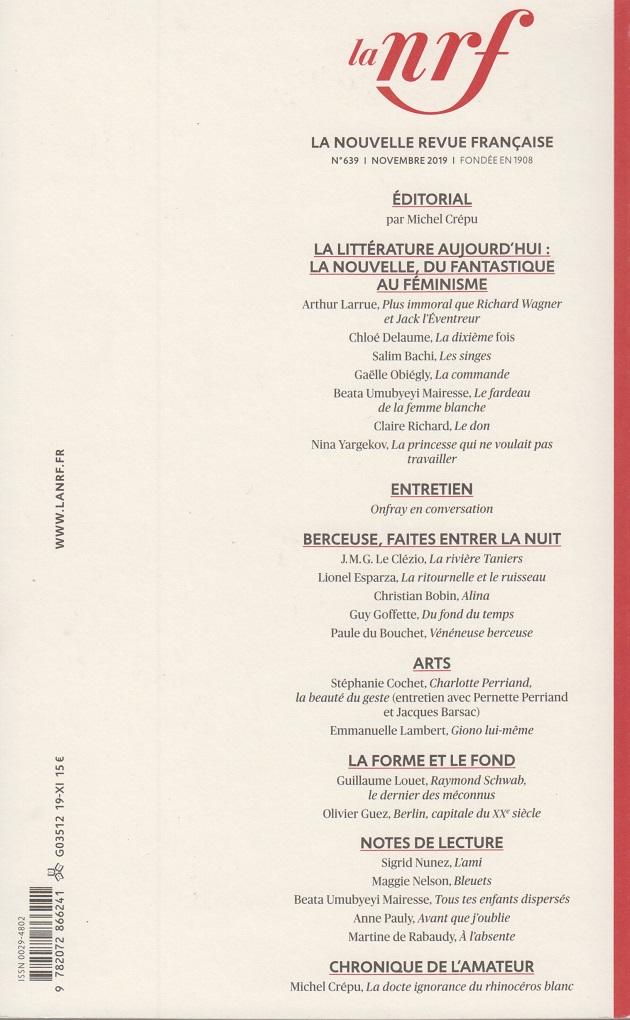
Arthur Larrue (Lisbon) informs us that a short story that he has written about Alekhine, as well as Tartakower and Najdorf, set in Buenos Aires, September 1939, has been published on pages 15-30 of the November 2019 issue of La nouvelle revue française. [Broken link]
The title, ‘Plus immoral que Richard Wagner et Jack l’Eventreur’, is adapted from a grossly misjudged remark about Alekhine by Harold Schonberg quoted in The Games of Alekhine.
(11653)
Addition on 17 April 2020:
Jean-Pierre Rhéaume (Montreal, Canada) draws attention to a list by Normand Lamoureux entitled ‘Bibliographie sur le jeu d’échecs dans la littérature française’.
Many chessplayers are sticklers for fact only regarding works of fiction.
Addition on 13 March 2021:
Editions Gallimard (Paris) has just published a novel entitled La diagonale Alekhine by Arthur Larrue, a 285-page paperback:
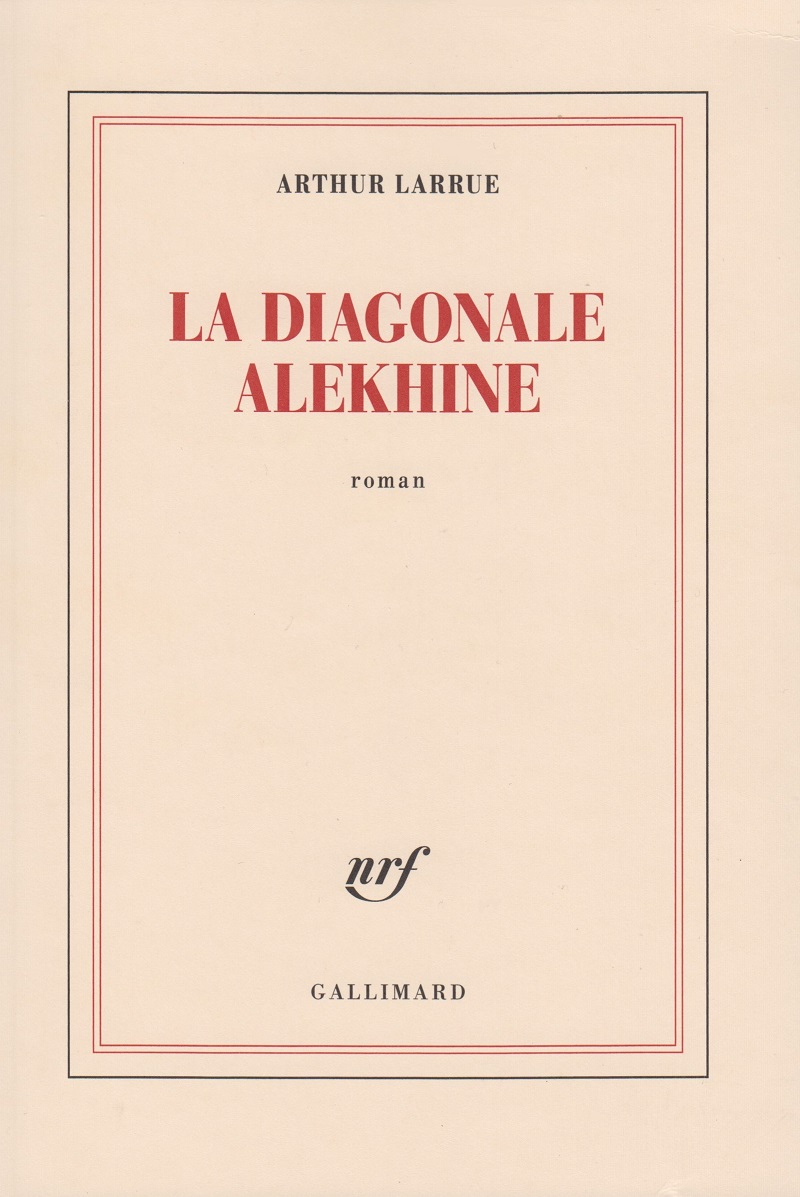
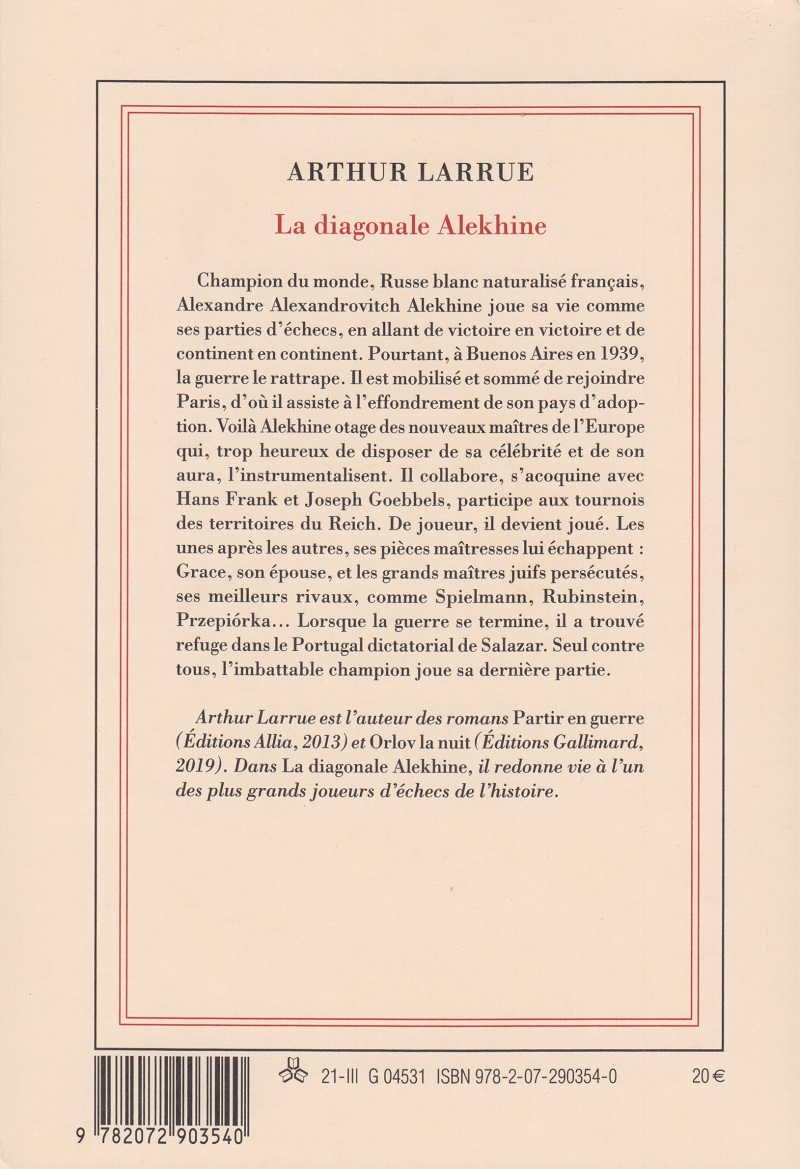
Addition on 10 December 2022:
Joselito P. Marcos (Cabanatuan City, the Philippines) draws our attention to the short story ‘No Greater Love’ by James R. O’Mahoney, published on pages 25-28 of the Catholic magazine Columbia.
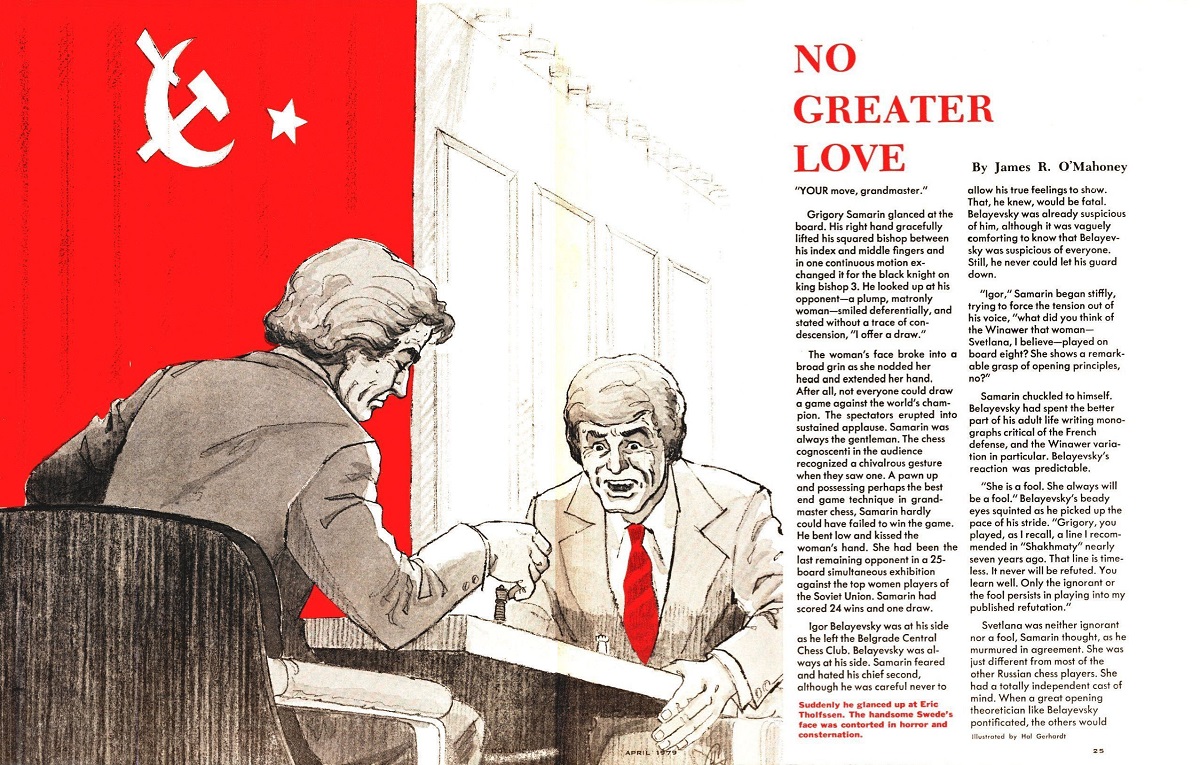
Paul Kollar (Oxford, CT, USA) has recently been re-reading Herman Melville’s posthumous work Billy Budd, Sailor, and has come across the following passage (page numbers vary according to the edition):
‘The sailor is frankness, the landsman is finesse. Life is not a game with the sailor, demanding the long head; no intricate game of chess where few moves are made in straightforwardness, and ends are attained by indirection; an oblique, tedious, barren game hardly worth that poor candle burnt out in playing it.’
(11966)
The latest book featuring the Wallace murder case is an elegant novel by Anthony Quinn, The Mouthless Dead:
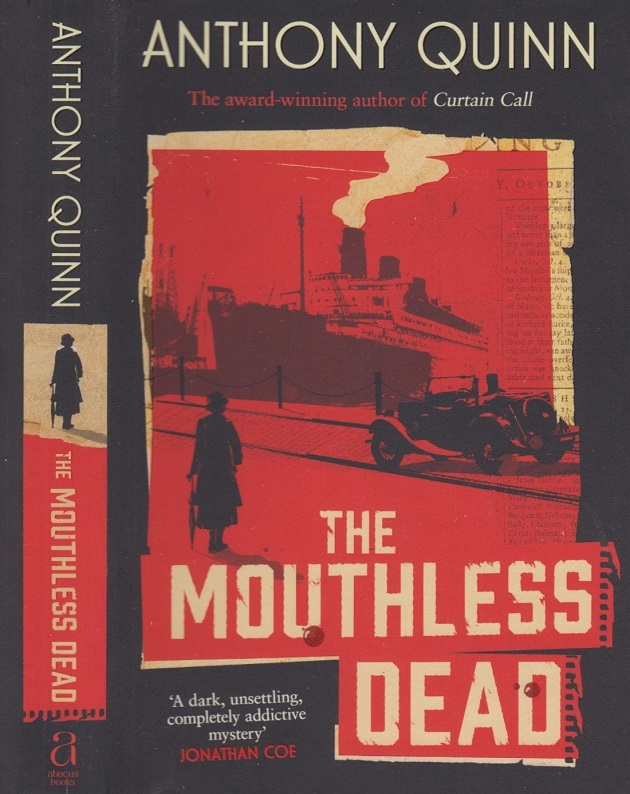
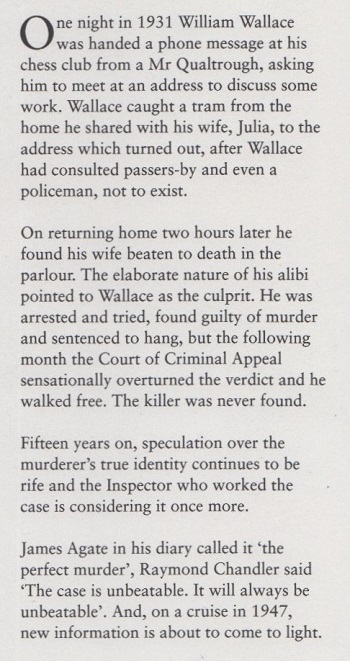
The phrase ‘the mouthless dead’ is from the first line of a posthumously published poem by Charles Hamilton Sorley (1895-1915).
(12133)
The above compendium is naturally far from exhaustive. See too our feature articles on Henry James Byron, Agatha Christie, Charles Dickens, Lord Dunsany, Sherlock Holmes, Edgar Allan Poe, William Shakespeare and Stefan Zweig.
To the Chess Notes main page.
To the Archives for other feature articles.
Copyright: Edward Winter. All rights reserved.